2022 Activity Report
March Activity Report
31 March 2023
Global Japan Office Coordinator
Kazumi Taguchi
The March London Report is about a talk given by Professor Hideaki Fujiki for the launch of his book Making Audiences: A social History of Japanese Cinema and Media, published by Oxford University Press. This event was organised by collaboration of SOAS-Japan Research Centre and Daiwa Foundation.
I was only able to join the talk for 25 minutes, but the contents are explained concisely in an abstract of the book which can be found on the website of the publisher, Oxford University Press. So, I am going to present the entire abstract here and add my translation in Japanese.
Abstract
This book explores the hundred-year history relationship between Japanese media and social subjects through an analysis of the connections between cinema audiences and five significant discursive terms: minshû (the people), kokumin (the national populace), tôa minzoku (the East Asian race), taishû (the masses), and shimin (citizens), which circulated in different periods from the 1910s through the present, while also overlapping in a way that indicates that the history of Japanese social subjects has unfolded in a multilayered rather than linear manner, through periods bounded up with and impacted by various political and economic issues, ranging from capitalism and total war to neoliberalism and risk society.
The book shows how in each context these five terms have not necessarily been deployed as a set of lexically defined, fixed, and stable meanings but have entailed certain discrepancies and contradictions among a diverse range of standpoints, their different interpretative valence changing according to historical context. Sometimes used to define the self and sometimes to define a given others, as well as being enunciated through discourses, the terms have been enacted by physical bodies. The book empirically and analytically elucidates a dynamic, multi-layered history of cinema audiences in Japan as part of a larger relationship between media and social subjects and examines cinema audiences as simultaneously shaped by and shaping social history. In so doing, it brings a new perspective to the history of Japanese society and culture in its global context from the early twentieth century up to the early twenty-first century.
Reference: https://academic.oup.com/book/41545
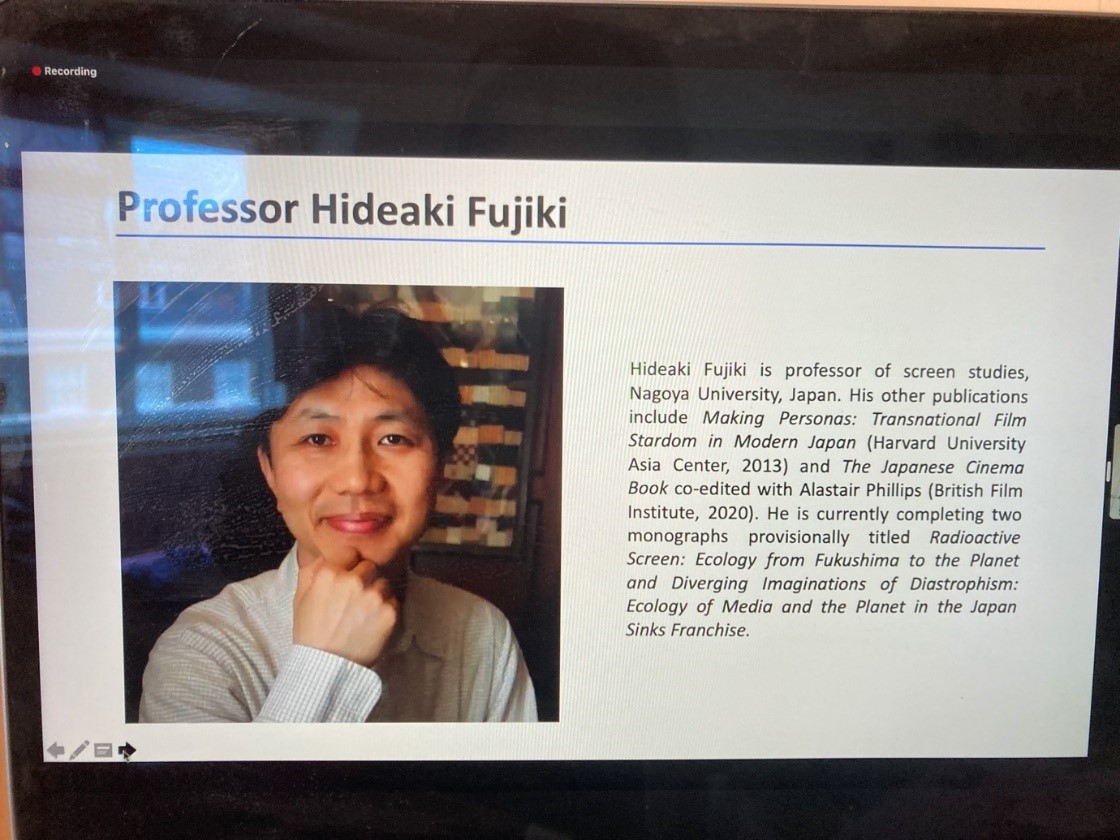
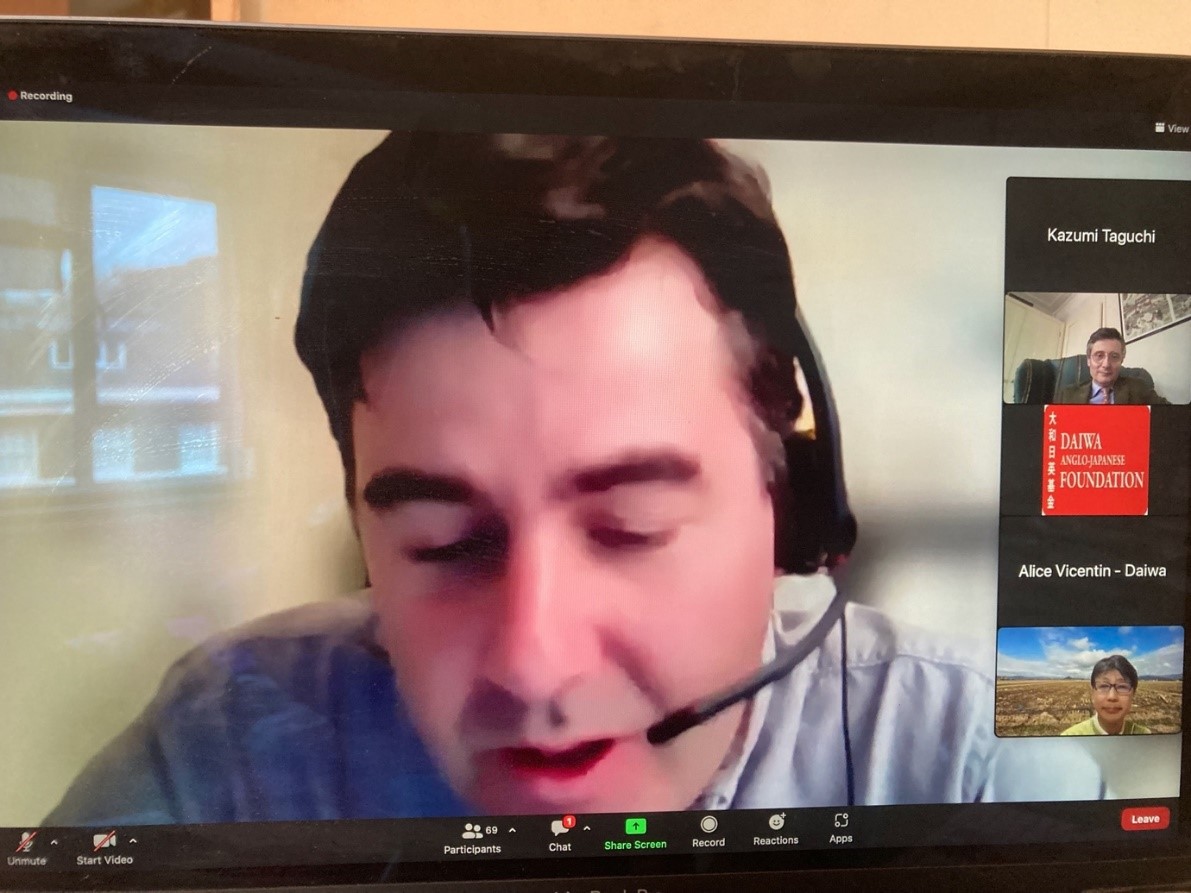
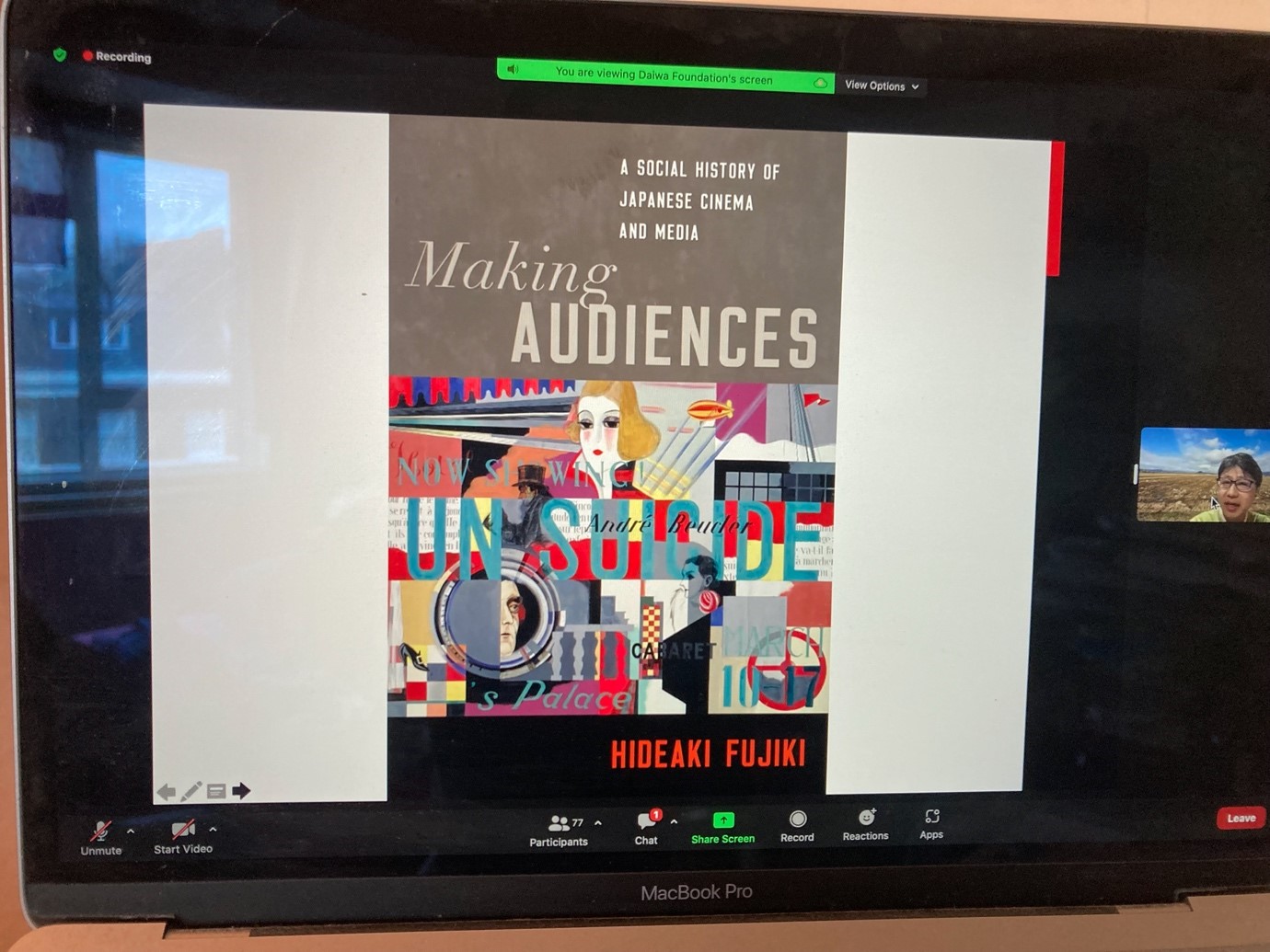
February Activity Report
28 February 2023
Global Japan Office Coordinator
Kazumi Taguchi
The February London Report is about a Noh Lecture and Workshop given by a master of the Kanze School which was organised by the JCR and CJAL (Dr. Meri Arichi and Dr. Kiyoko Mitsuyama-Wdowiak) and took place at SOAS.
Dr. Alan Cummings (The Head of the Department of East Asian Languages and Cultures, Senior Lecturer in Japanese Studies) introduced the Kanze school Noh actor, Wakebayashi Michiharu sensei to the audience.
Noh actor, Wakebayashi sensei and his family travelled to the UK to promote and increase awareness and understanding of Noh. They had come all the way from Kyoto, Japan and managed to squeeze this visit into a very tight schedule.
Wakebayashi sensei introduced himself in English and then gave a lecture which was translated into English by his daughter, Wakebayashi Kanako, who is a Shirabyoshi performer.
The contents of his lecture were: 1) What is Noh? 2) Zeami and His Words, 3) Noh Theatre & Props, 4) New Approaches of Noh, 5) Tradition and Succession
1) What is Noh?
We heard how Noh is all about the actors’ performance on stage and consists of the leading actor, supporting actor, leading actor’s companion and musicians (drum with sticks, hip drum, small drum, flute and singers). We also learnt of the relationship between Noh and Kyogen (slapstick comedy) and about the three major traditional performing arts in Japan: Noh, Kabuki and Bunraku. We were told something of Noh’s history, how the third Ashikaga Shogunate, Ashikaga Yoshimitsu was an important patron of Noh as were a number of military leaders among them, Oda Nobunaga and Toyotomi Hideyoshi, and.were informed of how the status of Noh performers was raised to Samurai class during the Tokugawa Shogunate.
Noh has faced two crises in its history: the Meiji restoration and the First and Second World Wars.
There are five schools of Noh: Kanze, Hosho, Kita, Kongo and Konparu.
2) Zeami and His Words
We were introduced to the Noh actor, playwright, director and producer, Zeami who succeeded to the Kanze school from his father Kan’ami in the early Muromachi period.
3) Noh Theatre & Props
Wakebayashi sensei stressed that the most important essence in understanding Noh is imagination, that’s the element which unites the actor and the audience.
Wakebayashi sensei demonstrated the standing posture and the technique of expression of sadness using the hands. He also explained the reason why the Noh mask is slightly smaller than the size of the face, that’s so you can recognise an actor and enables him to show a different expression of feeling by adjusting the angle of the mask. He also stressed the importance of maintaining a basic posture for expressing the part through the mask, and how props such as the Noh costume and fan can be used to represent objects such as a sake cup, shield or sword.
4) New Approaches of Noh
Regarding the new approaches of Noh, they come in the form of collaborations between actors from different schools, utilising other forms such as the Western play and animation, and creating a new piece of work as well as collaborating with the fashion designer, Koshino Junko at her fashion show.
As regards teaching Noh, there are Noh lessons open to all age groups. Corporate leaders have also shown interest in learning Noh as an important cultural activity. During the Covid restriction period, there were many Noh lessons available online via zoom.
5) Tradition and Succession
Regarding how the tradition gets passed down the generations, Wakebayashi sensei used the Gion festival as an example and showed photos of Wakebayashi sensei preparing for the event with his children, Wakebayashi sensei’s father and grandfather could be seen preparing for the event, and showing the method they use to keep Noh costumes in mint condition.
--------------------------
After the lecture, there was a question-and-answer session. Dr. Alan Cummings acted as a moderator/interpreter. There were many questions from the audience which Wakebayashi sensei answered conscientiously, and Dr. Cummings interpreted the questions and answers remarkably well in both English and Japanese.
After the question-and-answer session, there was a mini workshop in which members of the audience tried out Noh dance. The play chosen was called “Oimatsu”. The participants showed their enthusiasm and performed a dance that featured a Noh sliding walk which used a fan as a prop.
To close the workshop, the audience practiced singing “Oimatsu” together.
The event lasted about an hour and a half, and we all thoroughly enjoyed a very intense and rewarding workshop which was rich in content.
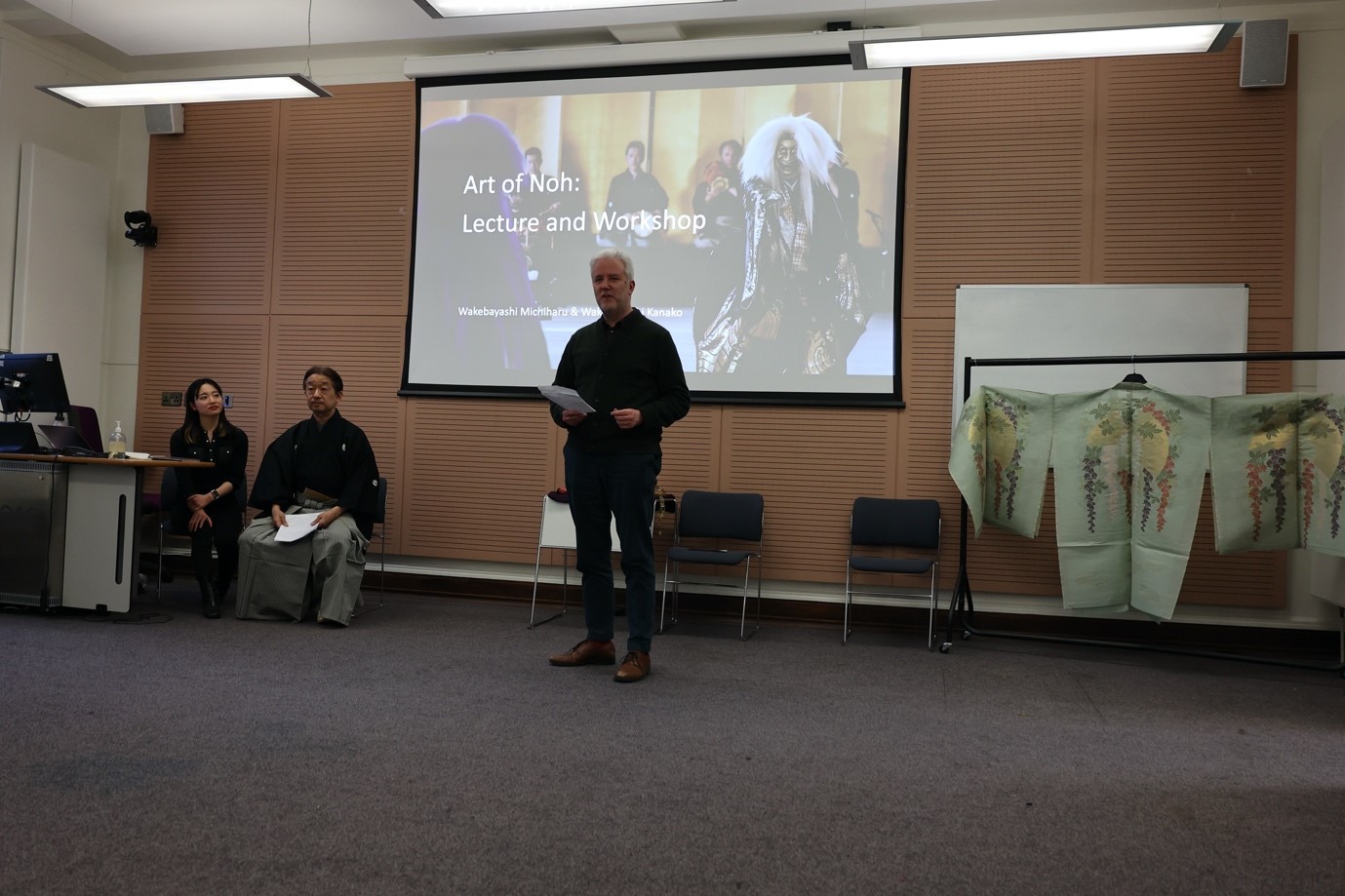
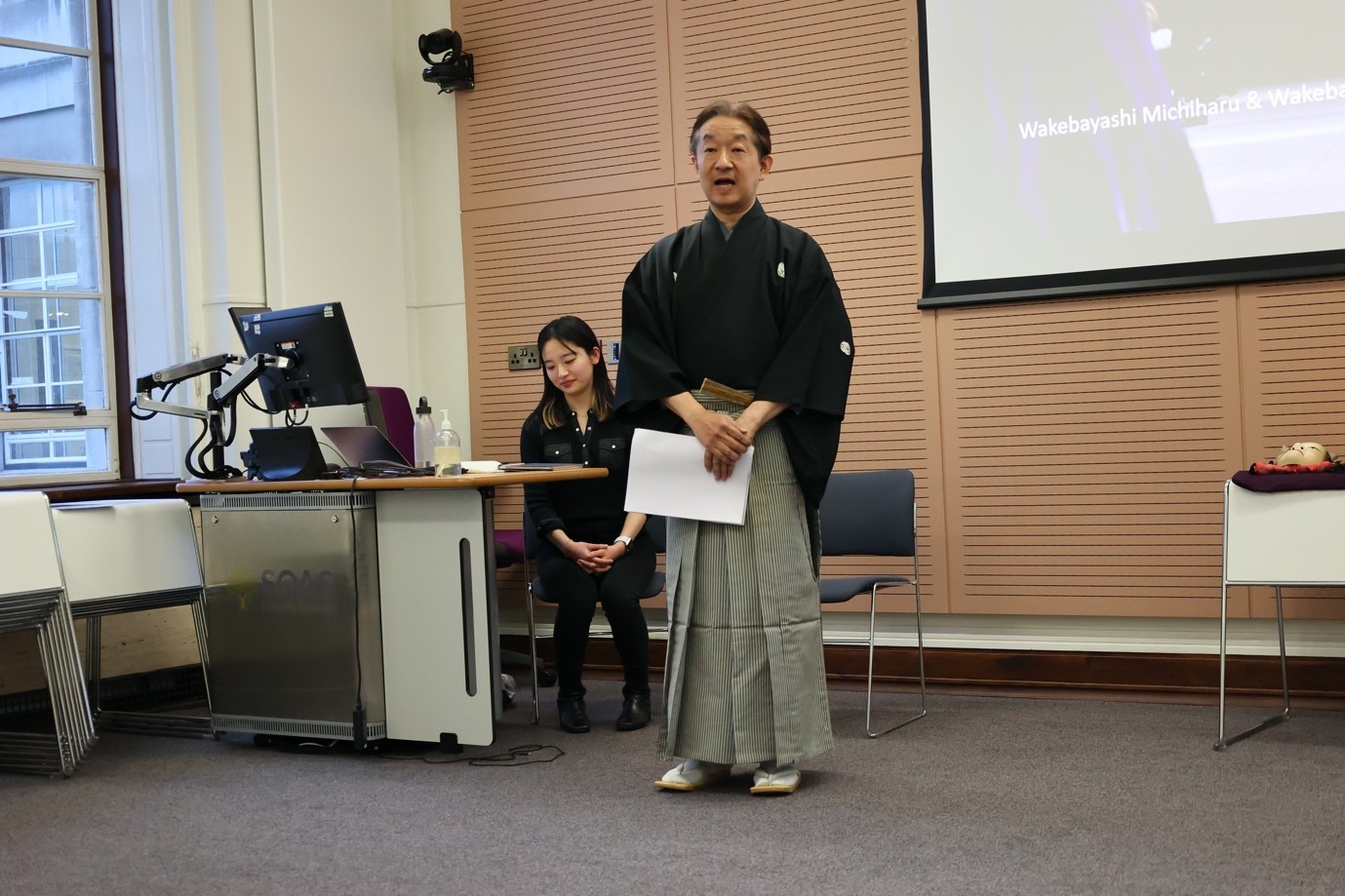
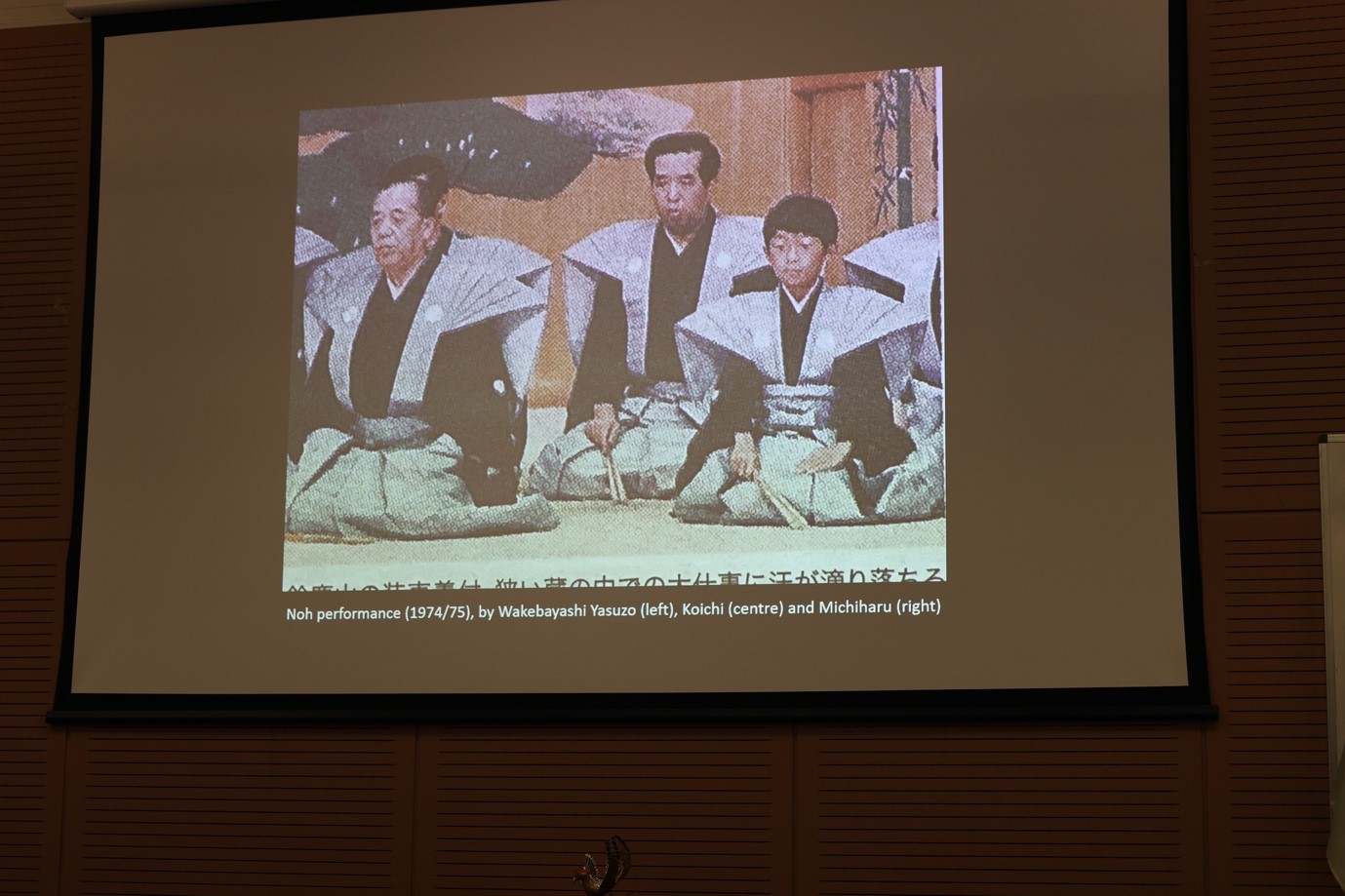
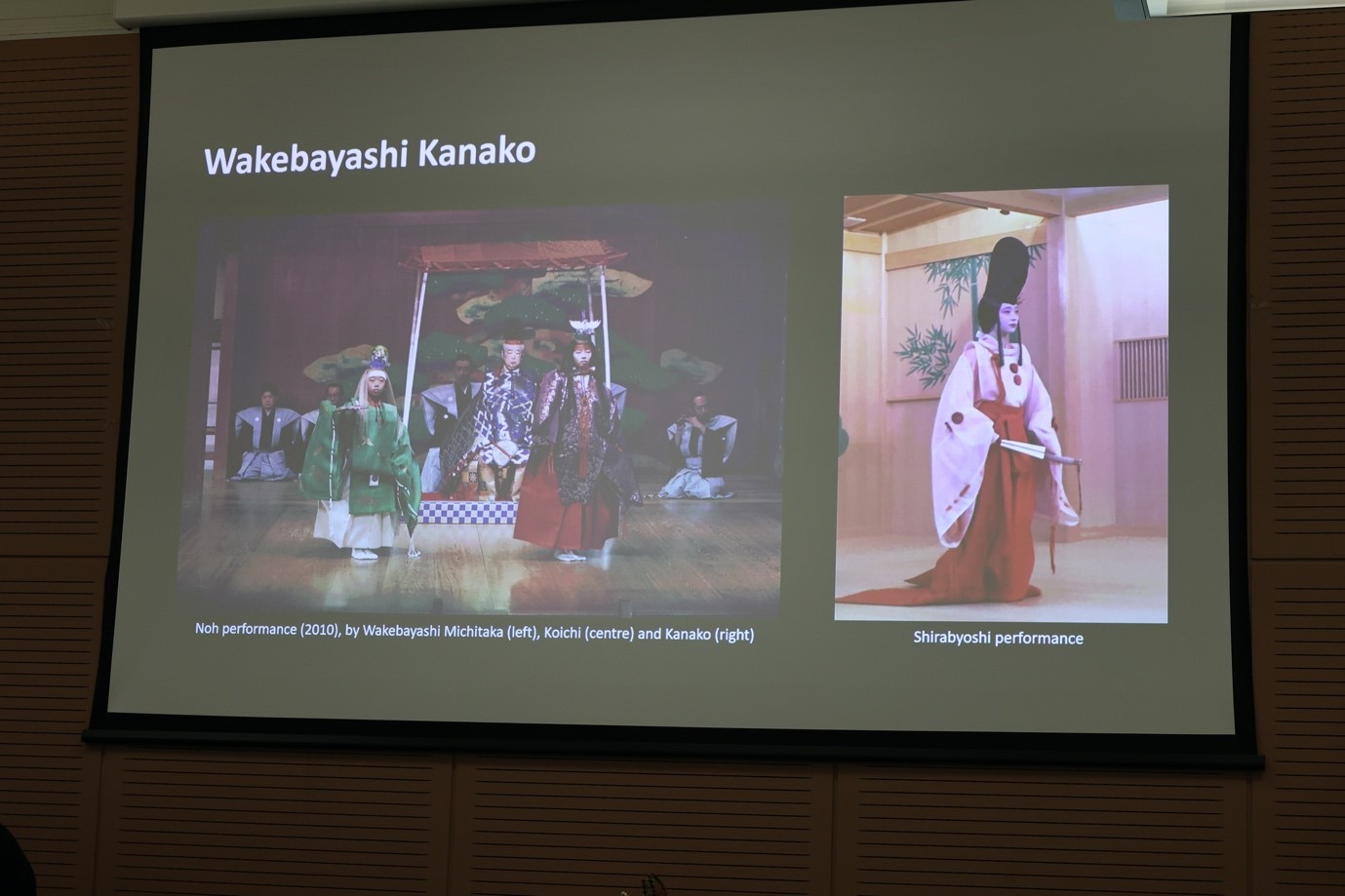
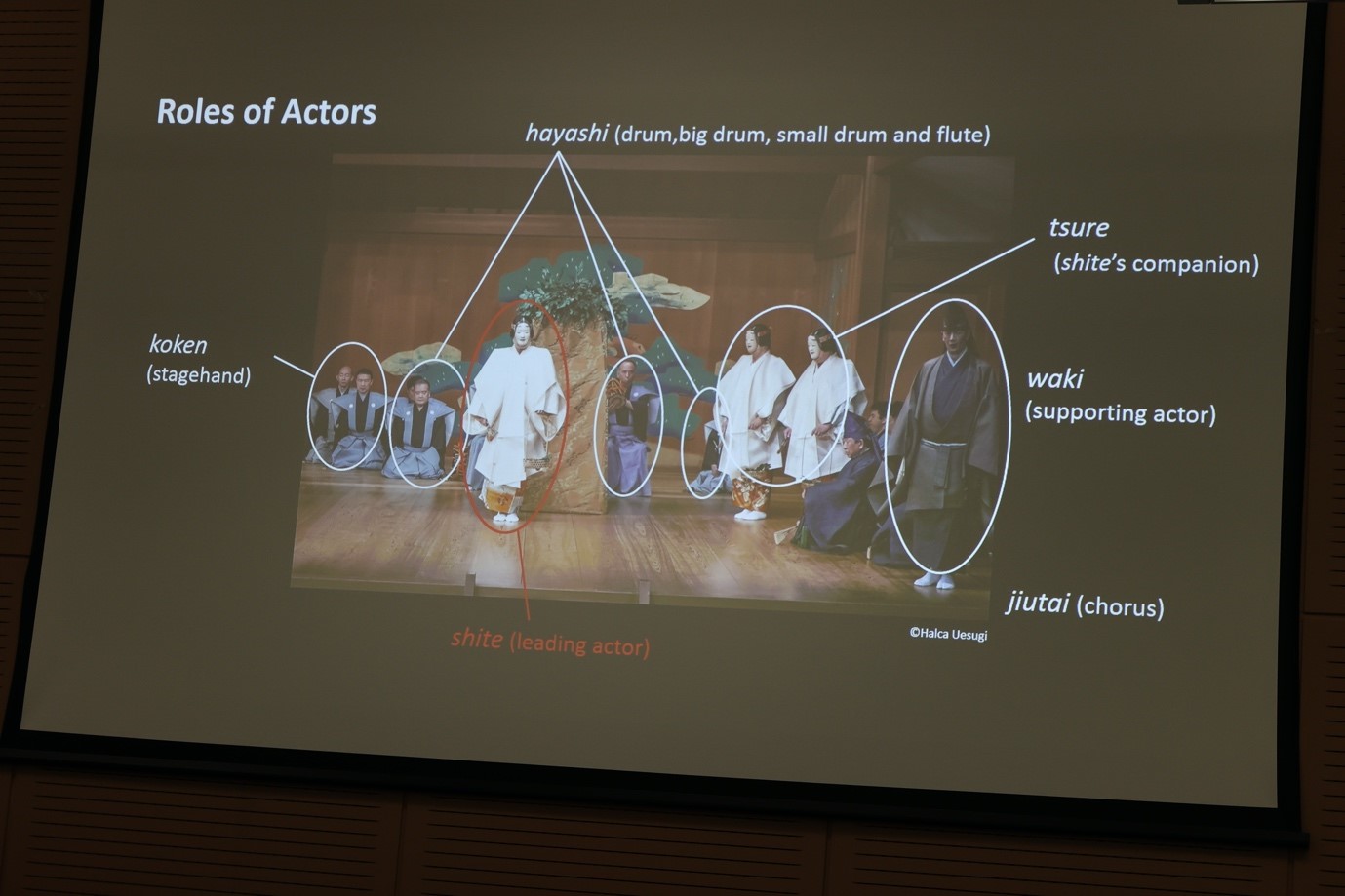
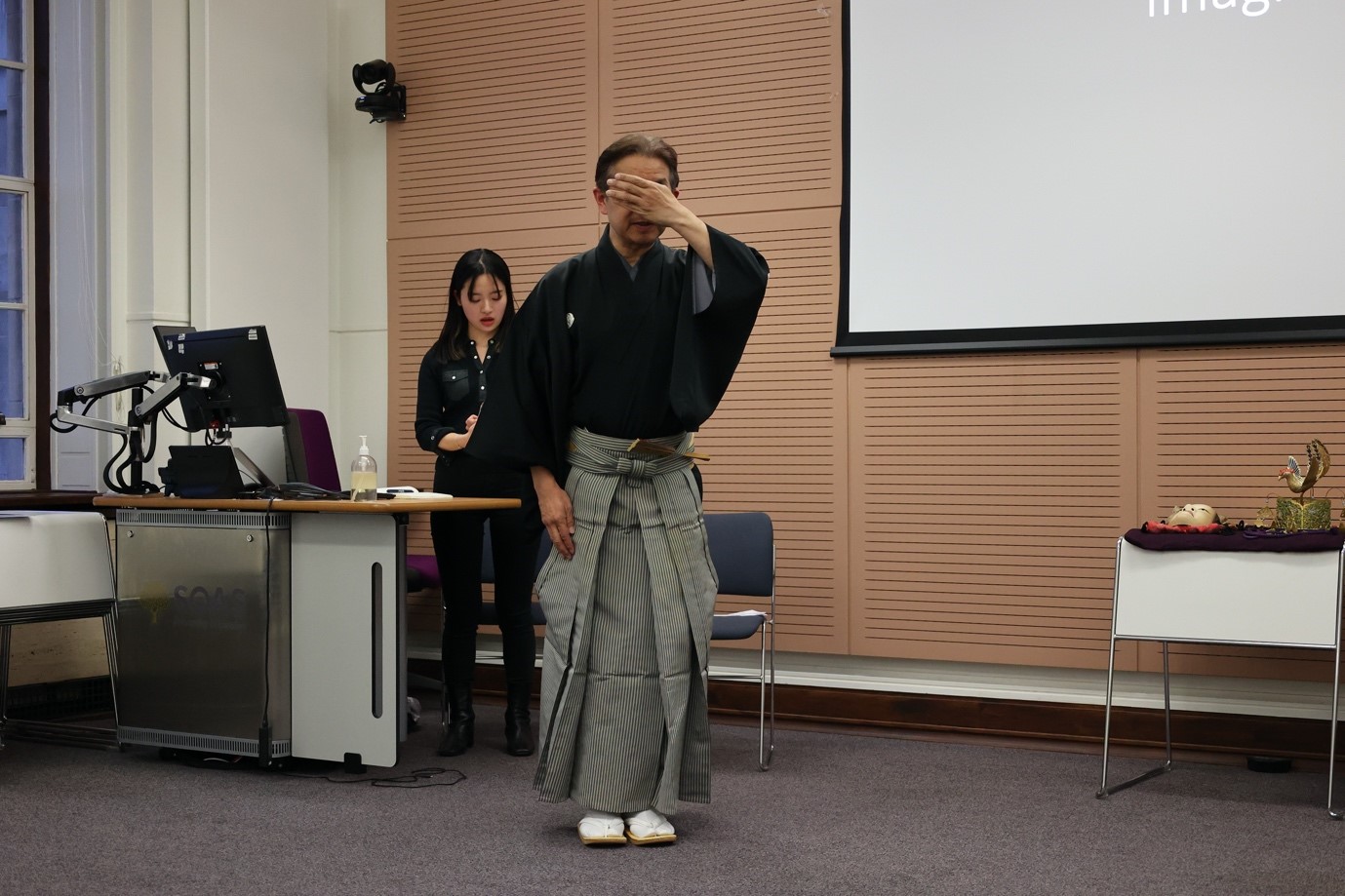
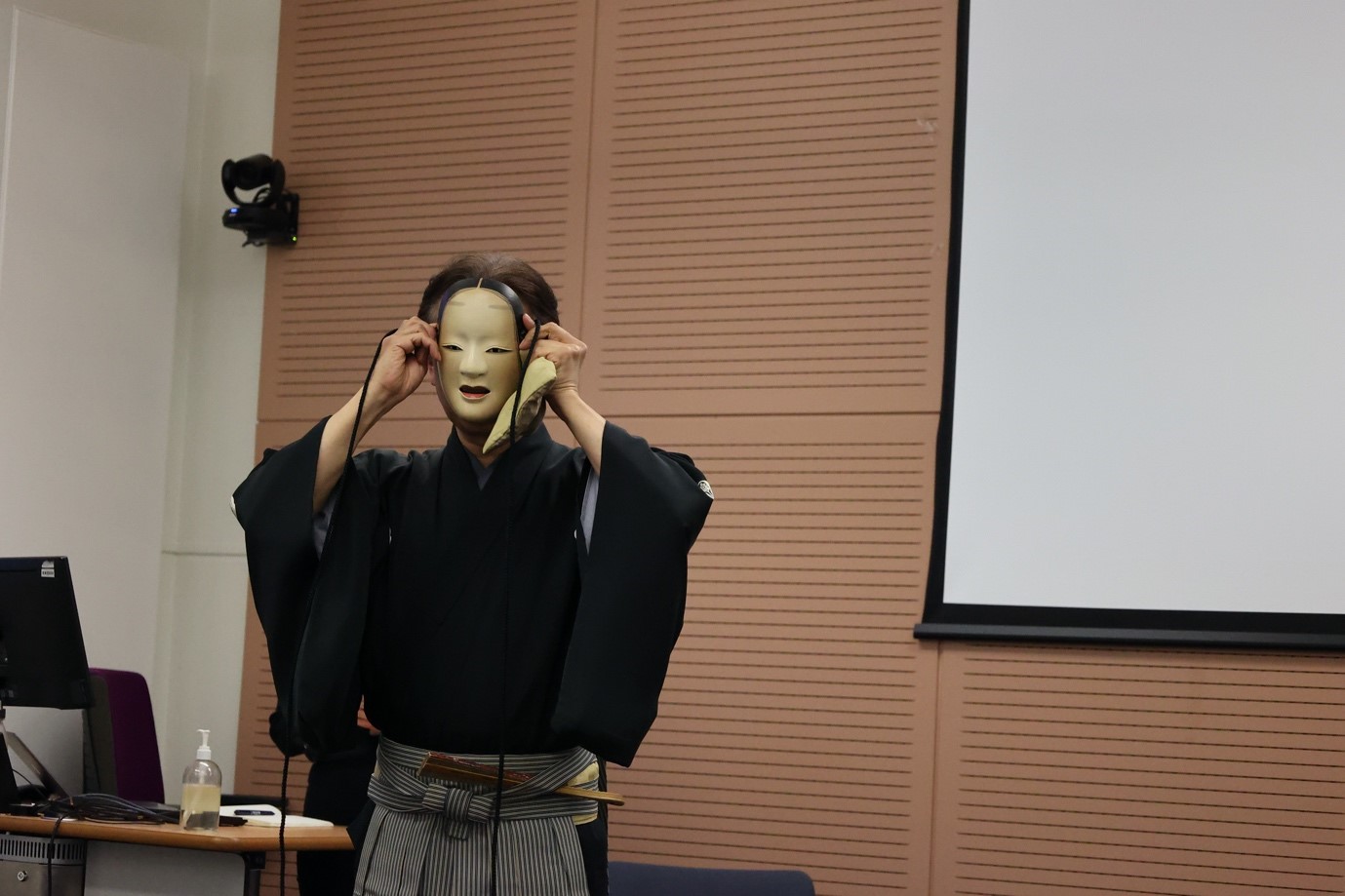
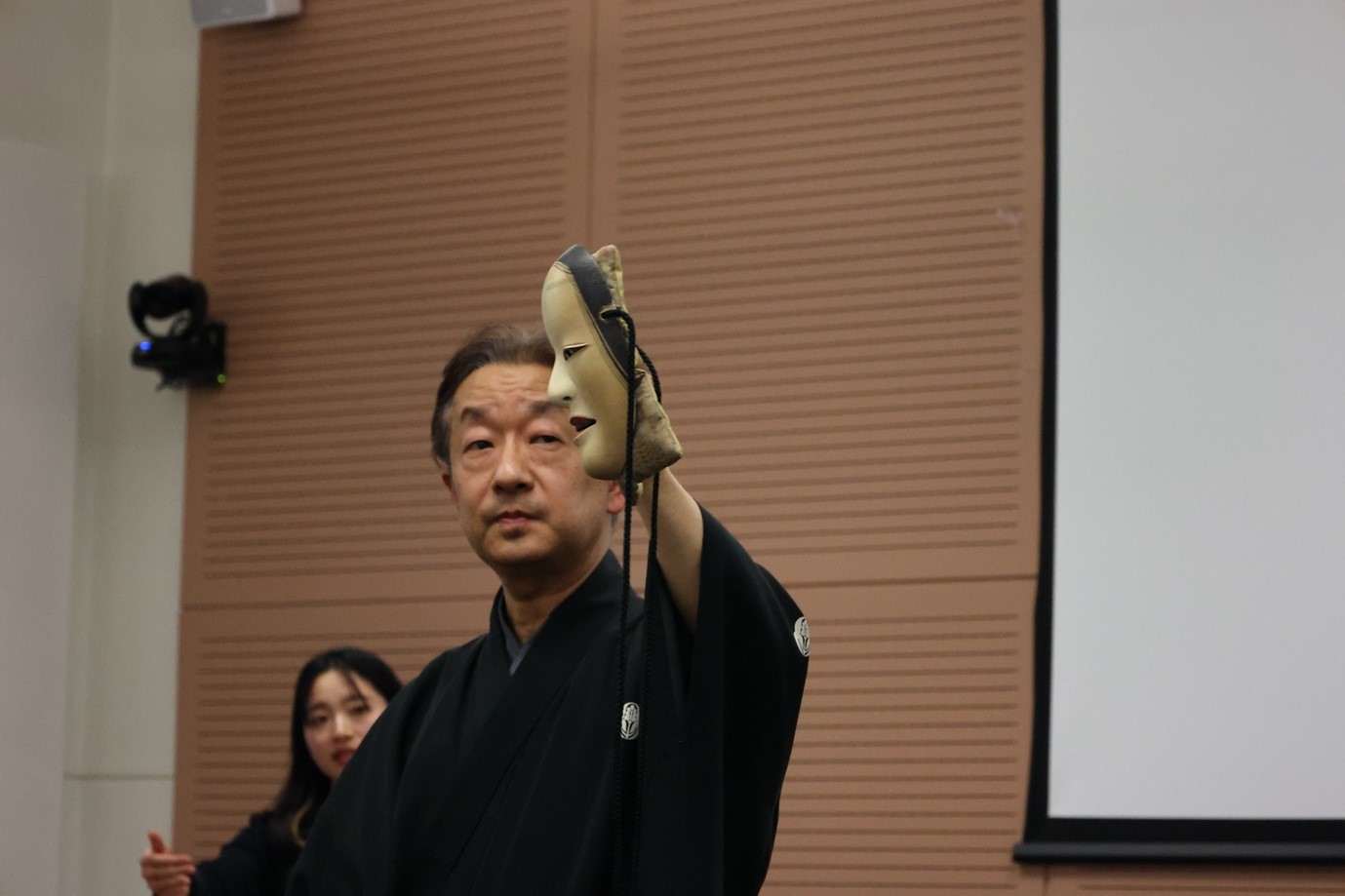
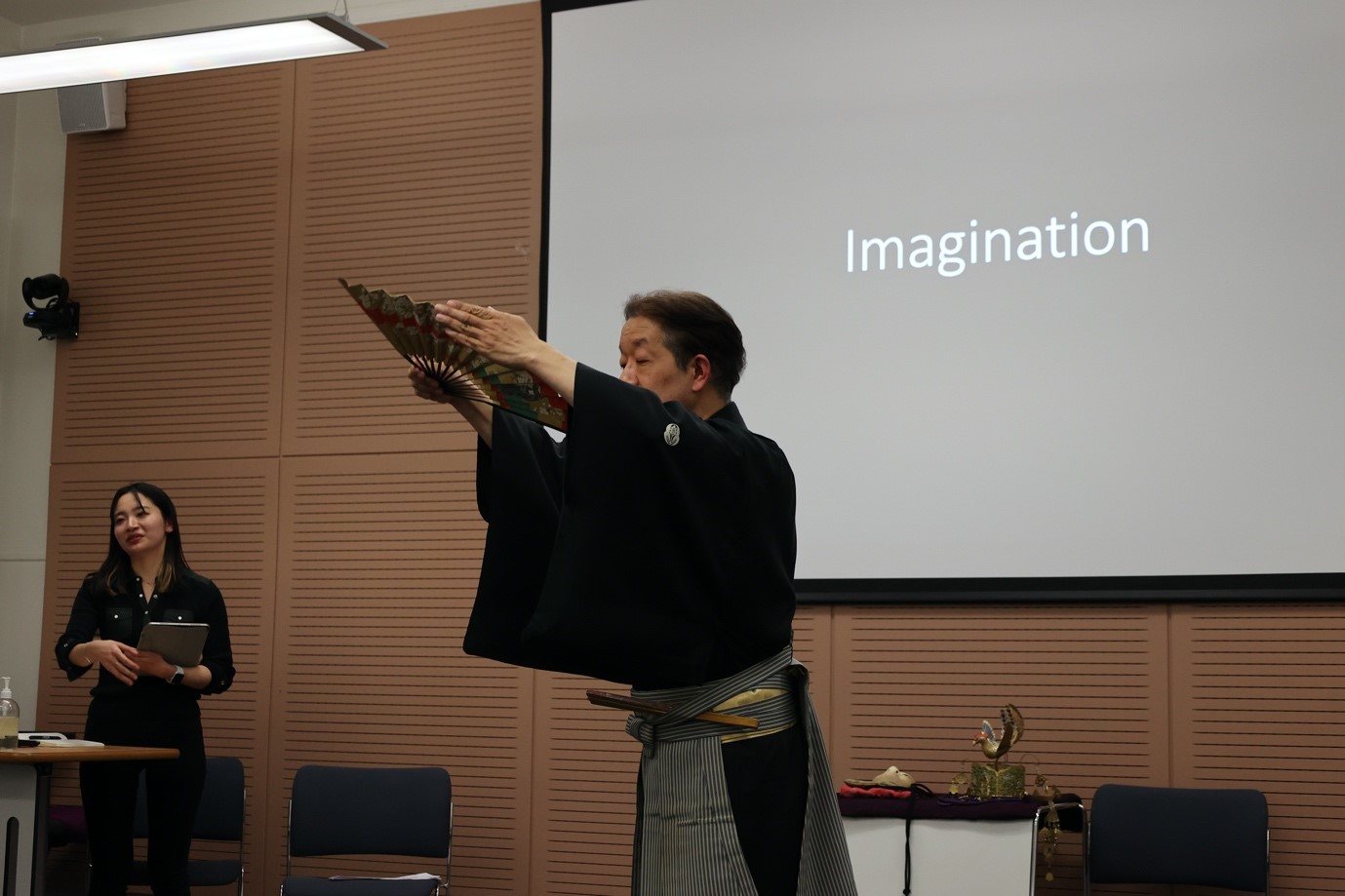
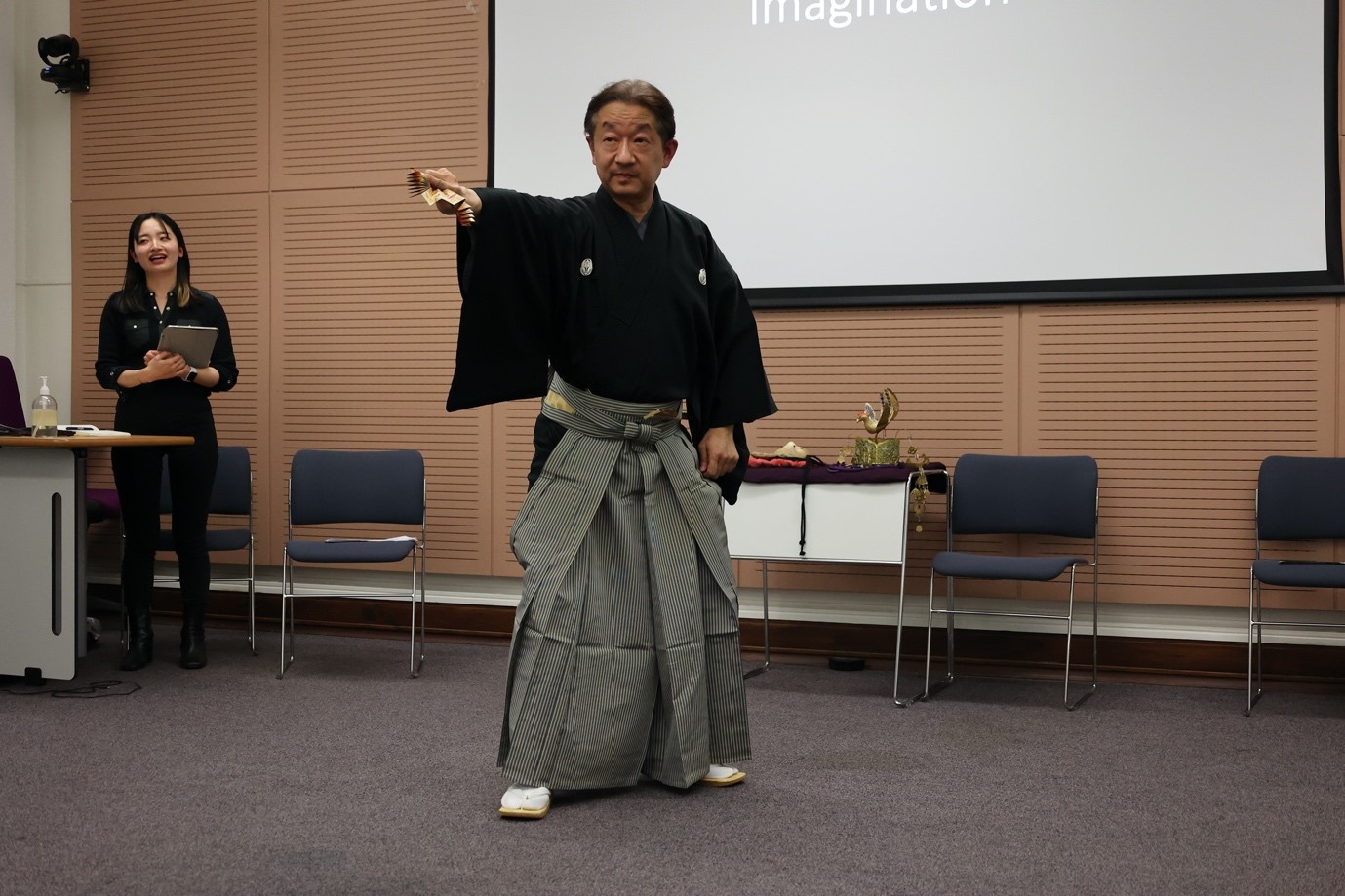
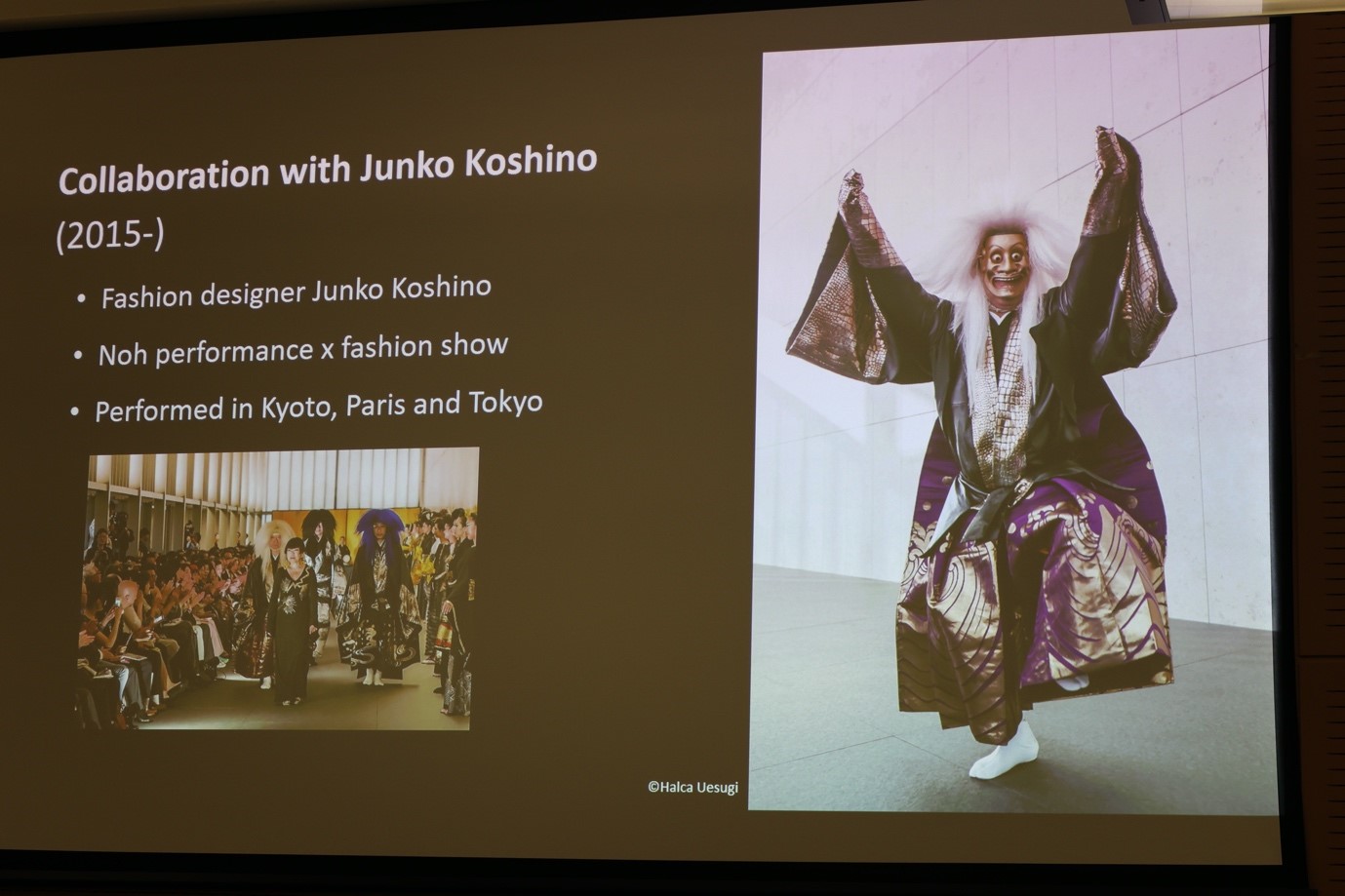
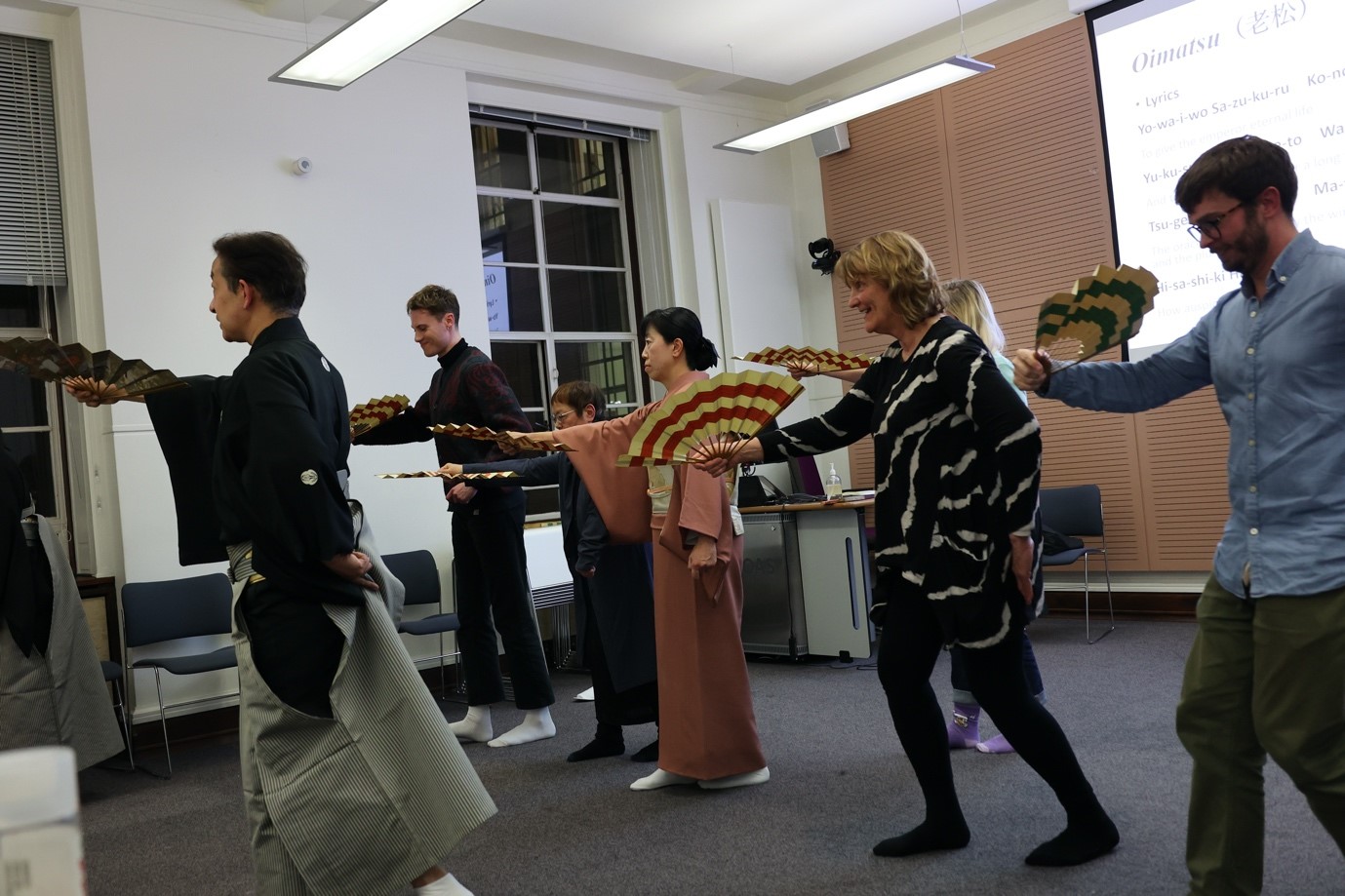
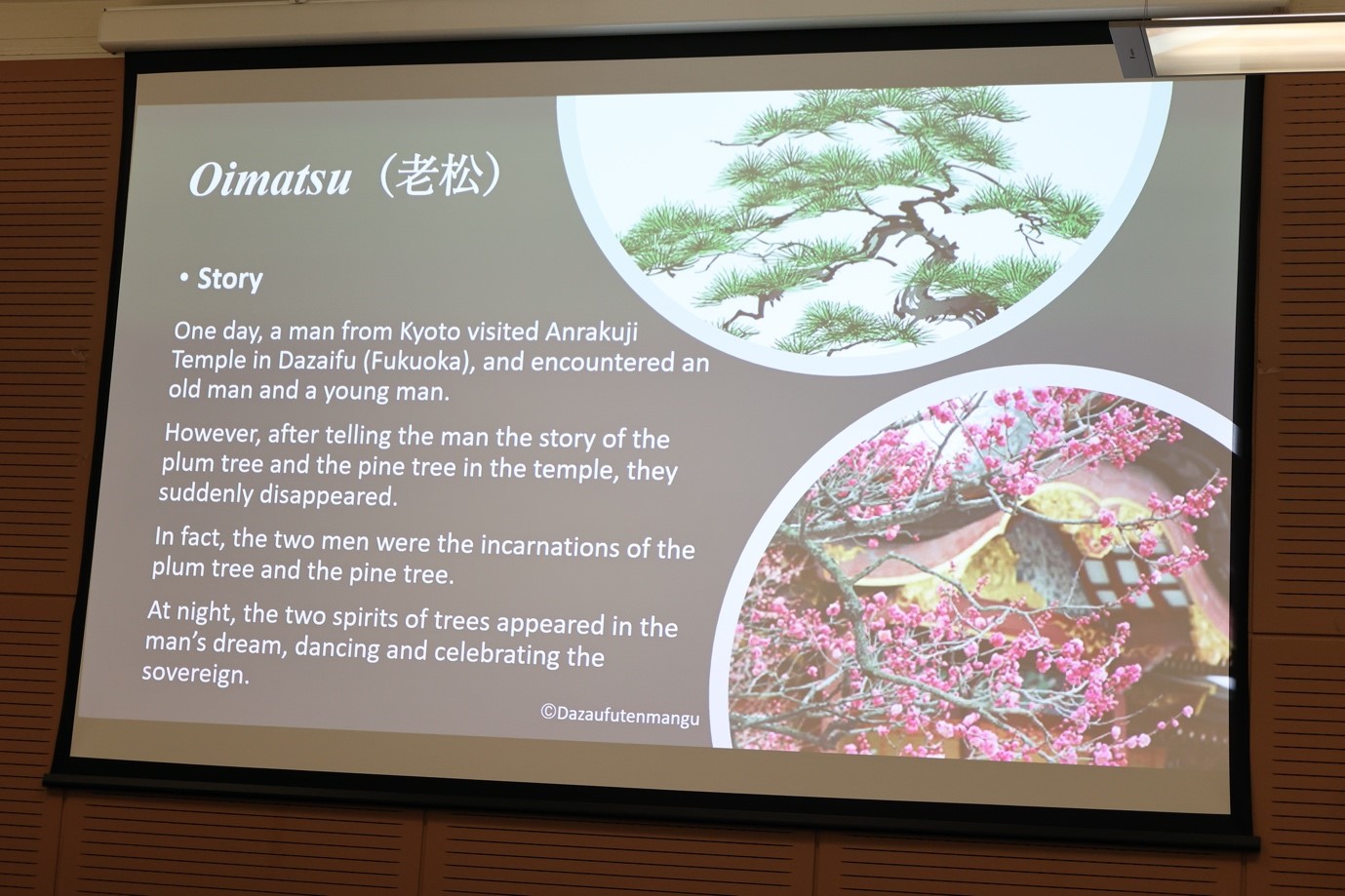
January Activity Report
31 January 2023
Global Japan Office Coordinator
Kazumi Taguchi
Happy New Year, everyone! I hope you all have a great year ahead of you.
The January London Report is about the strikes organised by a number of unions in the UK.
Recently there have been many demonstrations demanding a pay rise due to the critical situation in the cost of living caused by high inflation and a huge increase in energy bills which began last year. A serious and organised strike took place on the 1st of February.
According to the UK media, it was the largest scale strike in the last ten years. The strike was organised and joined by teaching staff in education and public transport as well as the border force and security guards. It is reported that as many as 500,000 people joined the strike causing chaos, damaging the routine of everyday citizens’ life and closing many schools.
More than 23,000 schools were shut down and the transport system for commuters was hit badly. According to the National Broadcasting service, more than 100,000 teachers working in secondary education in England and Wales participated in the strike.
University lecturers, civil servants, bus and train drivers joined strikes organised by their unions. The nursing staff and ambulance workers will be the next to follow their example.
The government is planning to bring in a new law to regulate strikes as a measure to handle the situation. However, there has been strong resistance from the unions and the situation is getting ever more tense.
In my opinion, it is necessary to bring in measures to suppress high inflation and to reduce the cost of energy bills. The best solution would be if the government made their citizens’ welfare their prime objective.
December Activity Report
31 December 2022
Global Japan Office Coordinator
Kazumi Taguchi
The December London Report is about showing a snowy London near SOAS and the firework event at the Thames River which saw out the old year and welcomed in the new one.
A great many unexpected things happened in 2022. In February, there was the invasion of Ukraine by Russia, followed by a sky-high increase in energy bills, an increase in the cost of living, flooding, record breaking high temperatures (over 40 degrees in London), the death of Queen Elizabeth II, changing the prime minister three times within a year and the World Cup in Qatar. A very full year seemed to go by in a flash.
We had the first snow fall in London in December and it was very cold for a while. But by the end of the year, the weather had become much milder.
The photos below are taken at Tavistock Square which I call Peace Square. It’s near SOAS, as is Russell Square, which had some lovely Christmas decorations. And the final photos are of the fireworks at the Thames celebrating the arrival of the new year as seen from my apartment.
I wish you all a safe and peaceful 2023.
I’d like to thank you all and look forward to your continuous support next year!
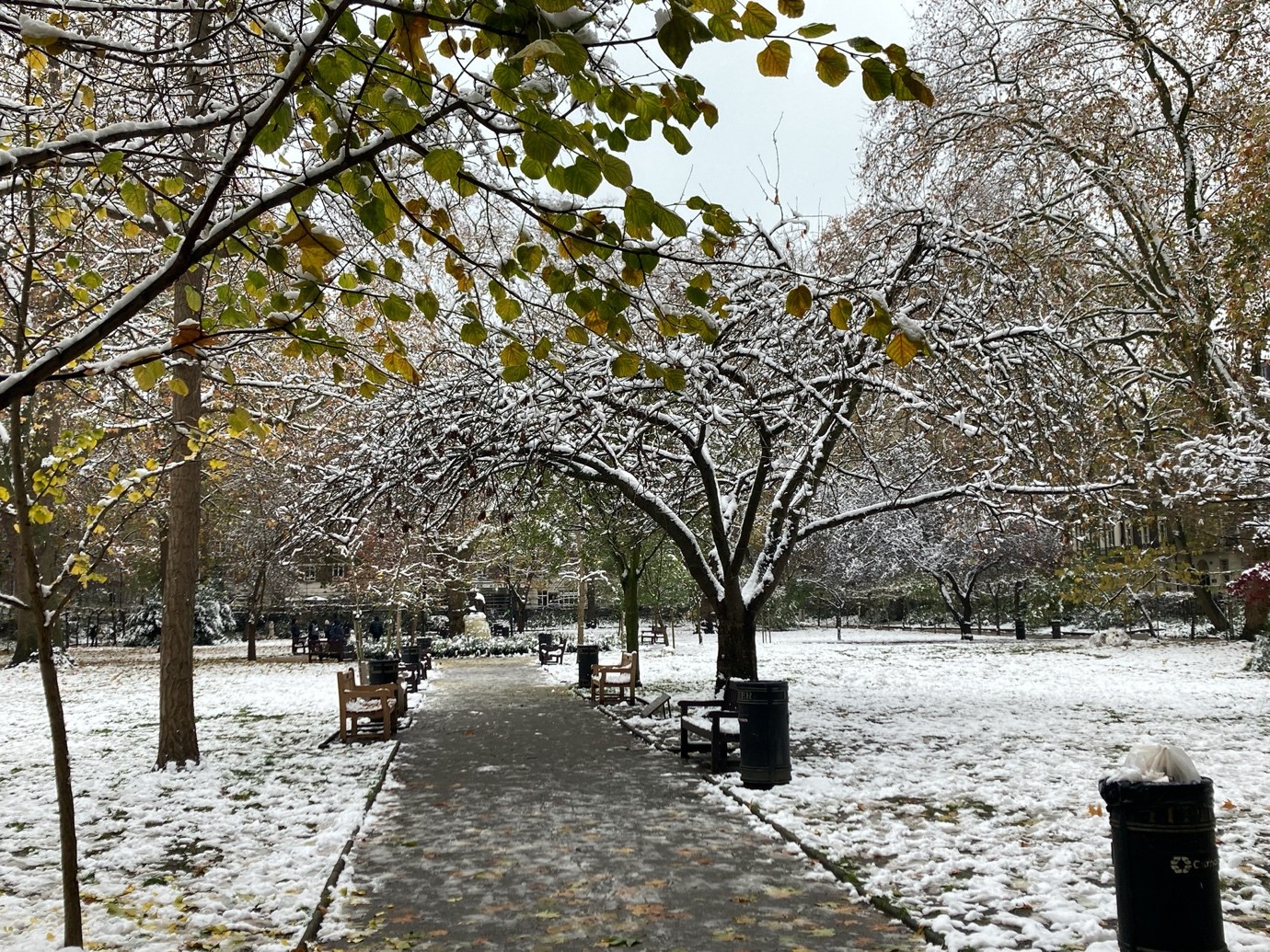
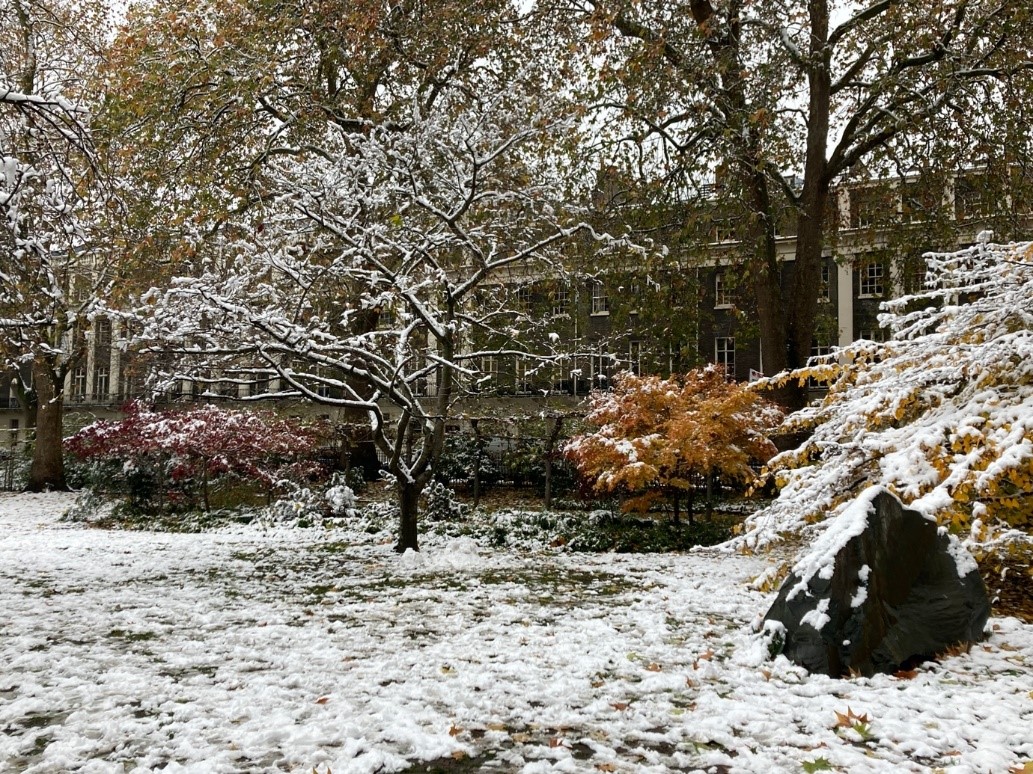
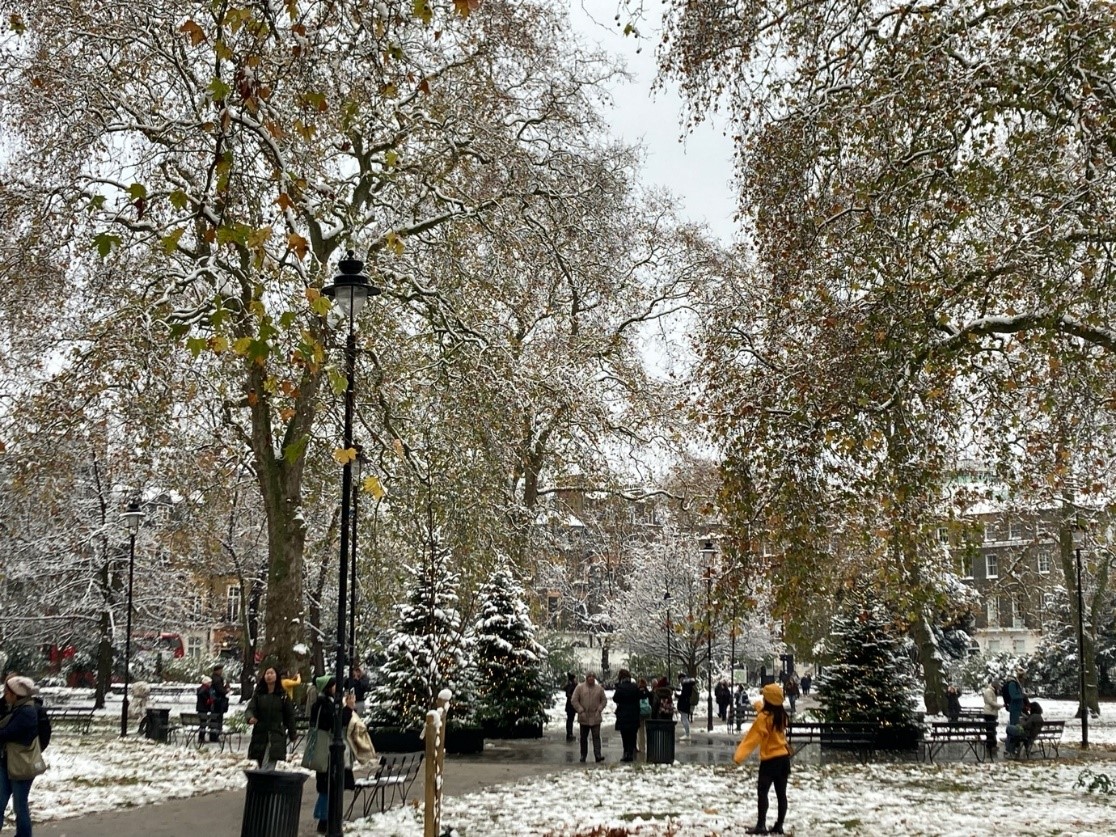
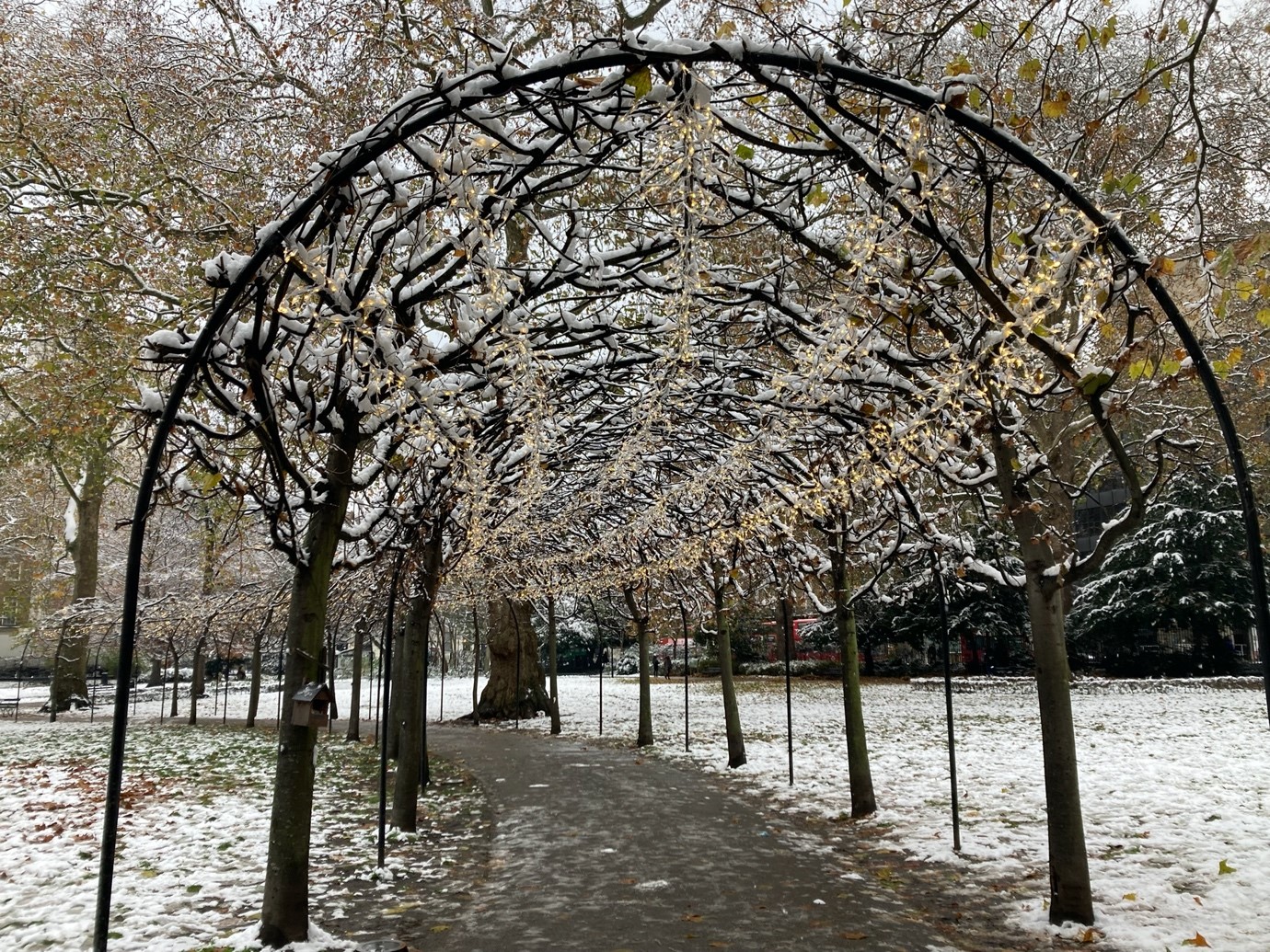
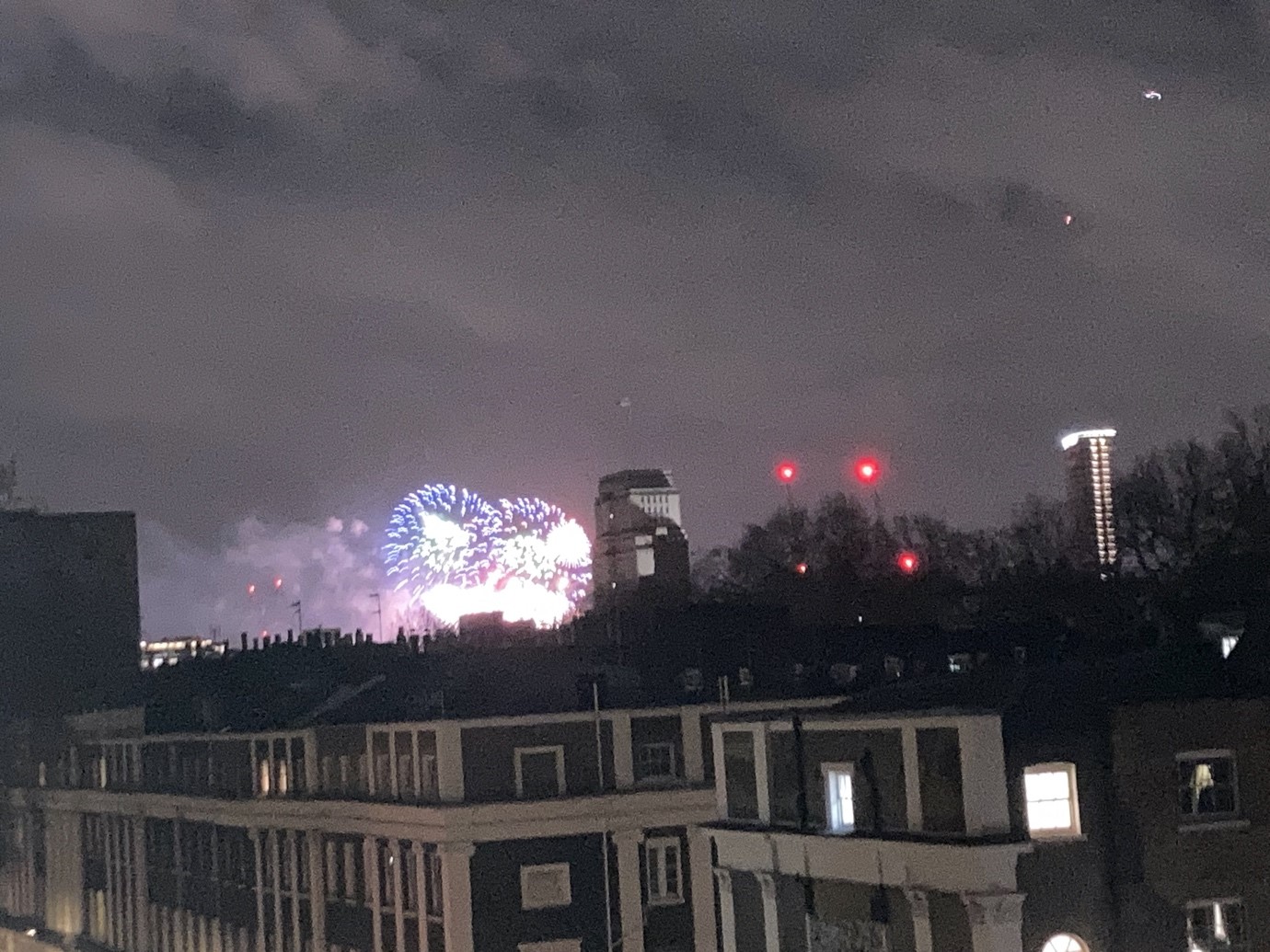
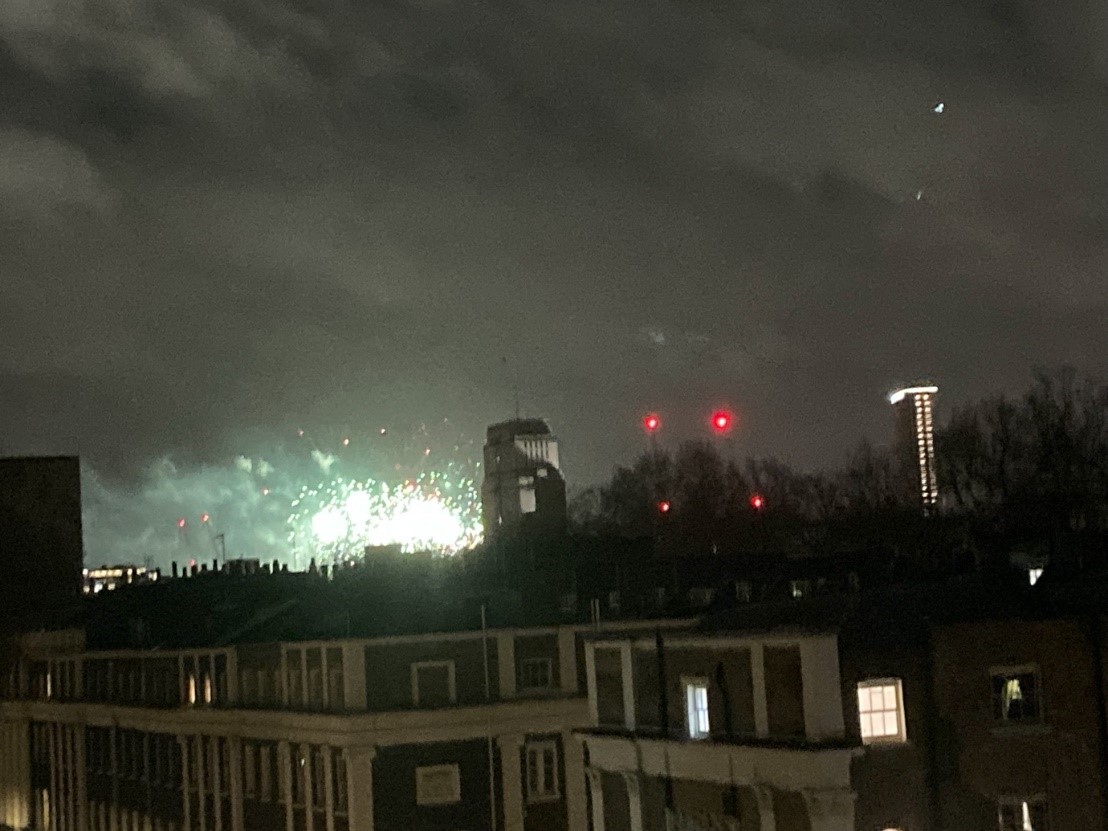
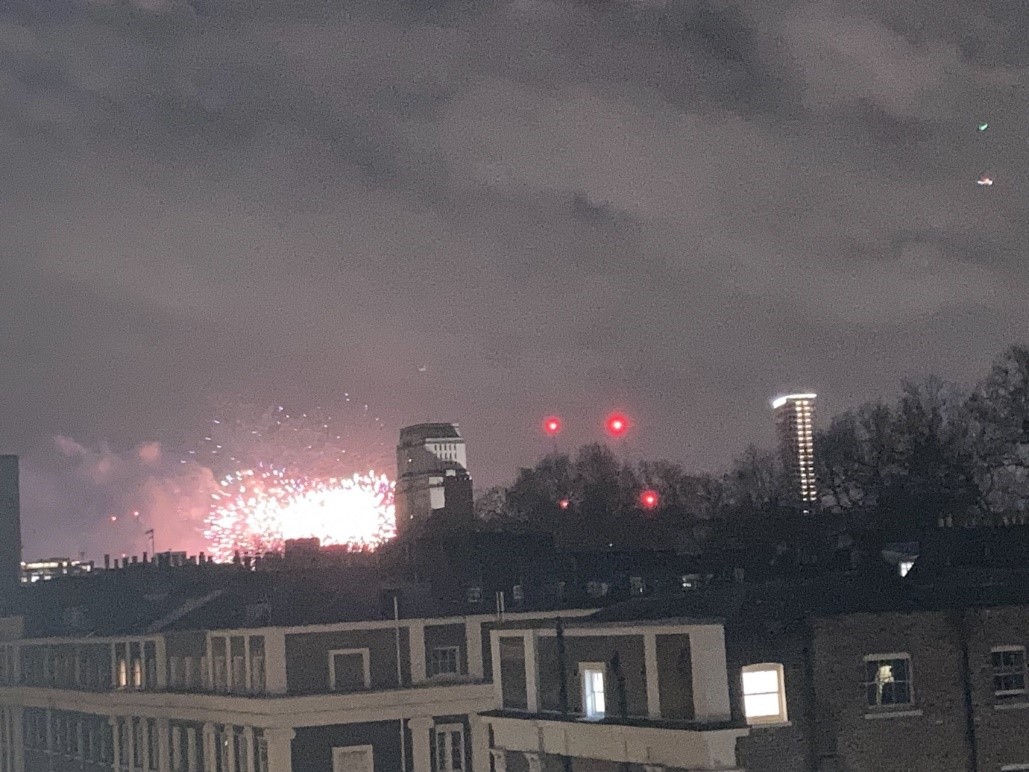
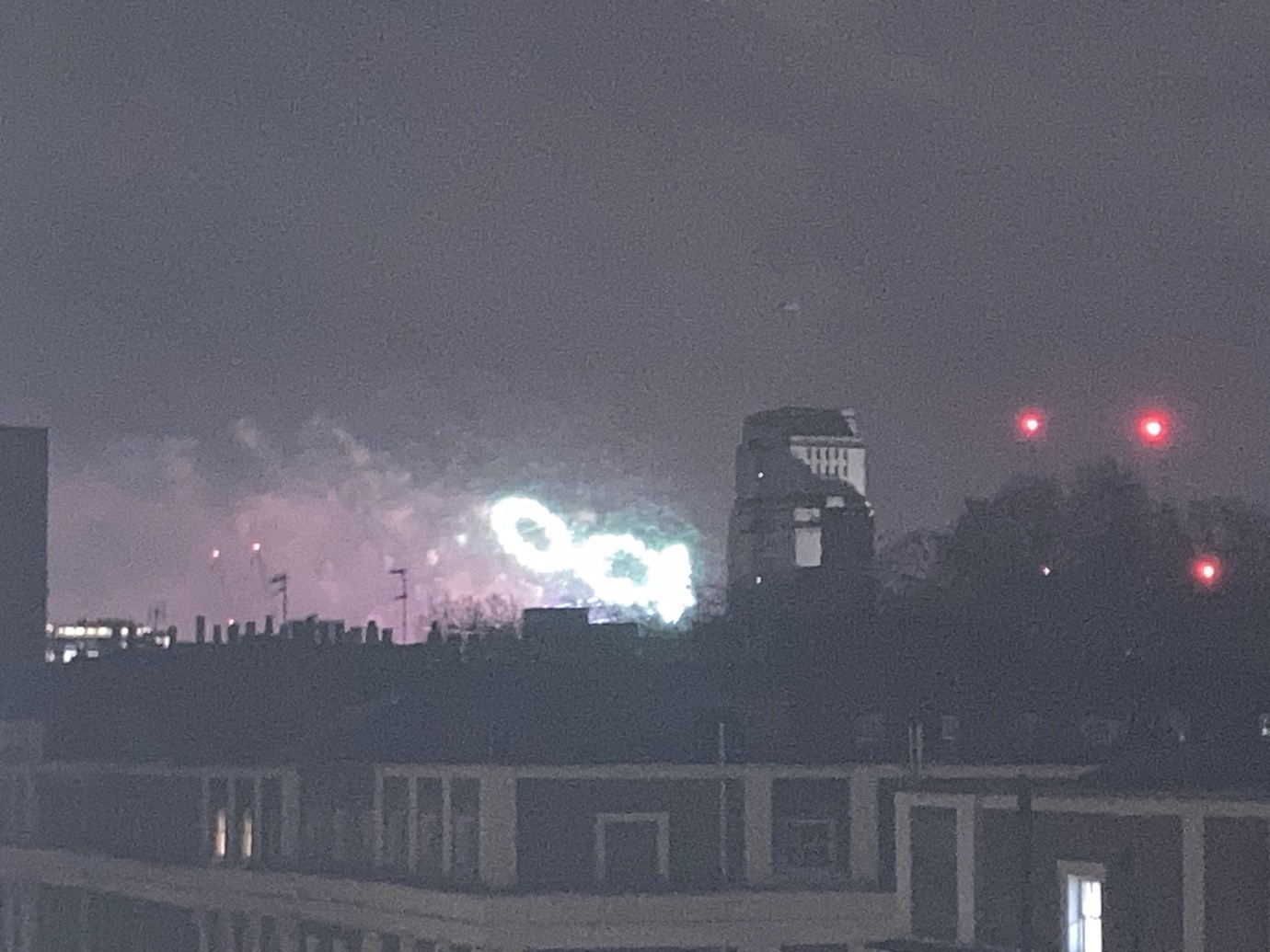
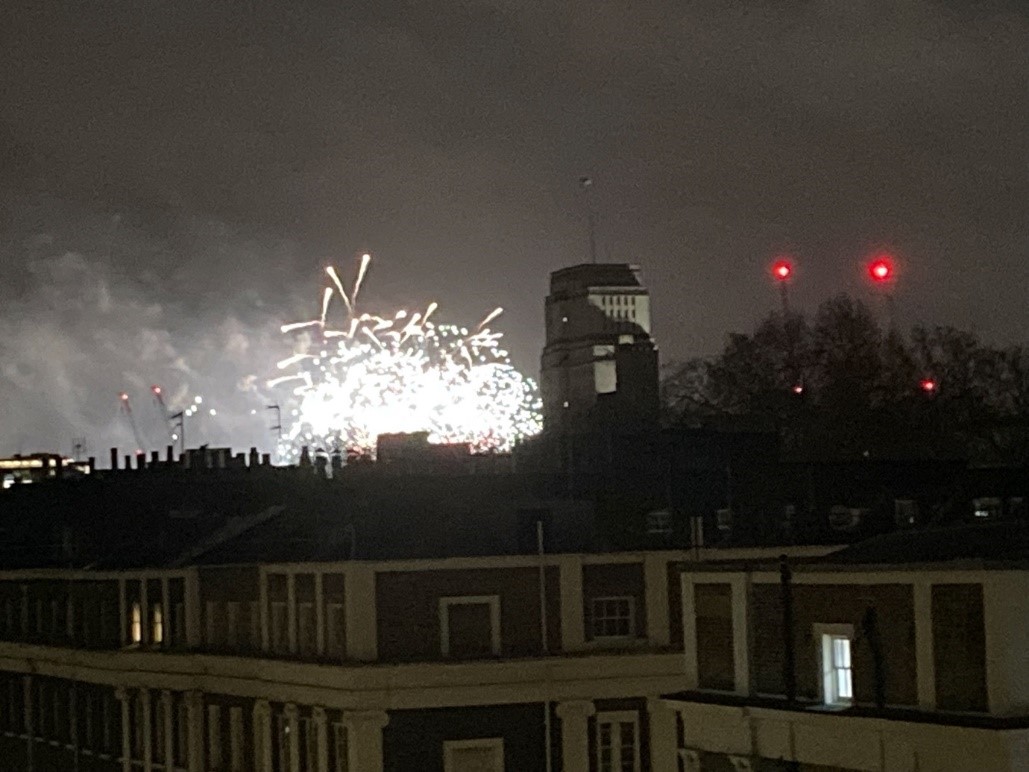
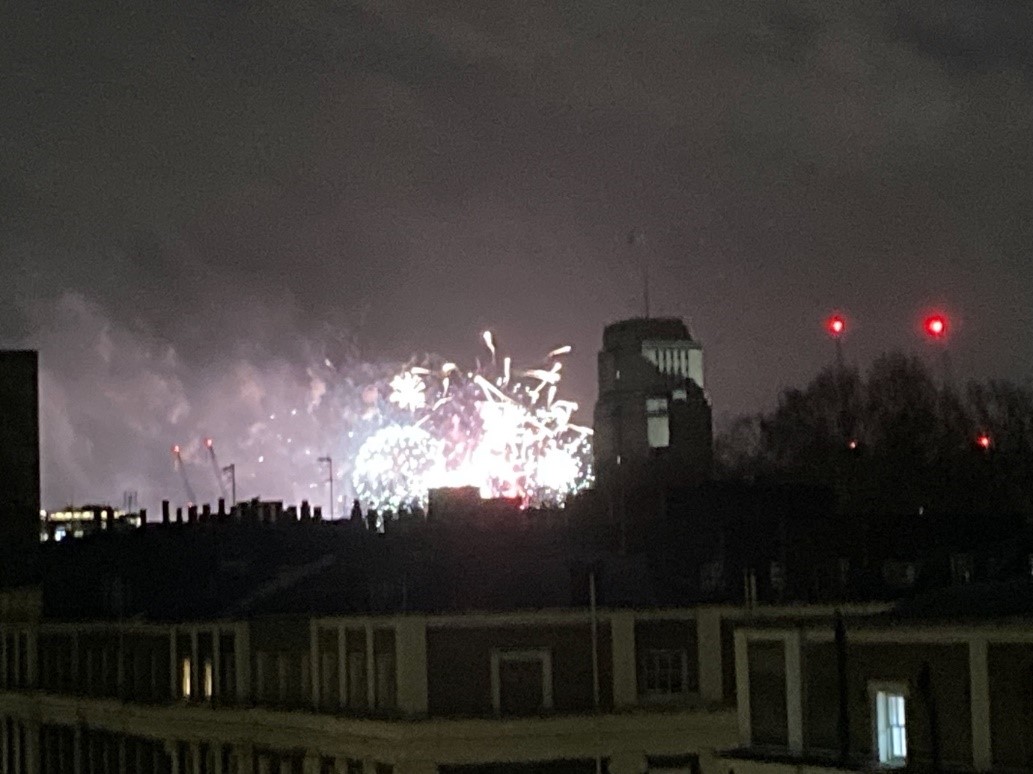
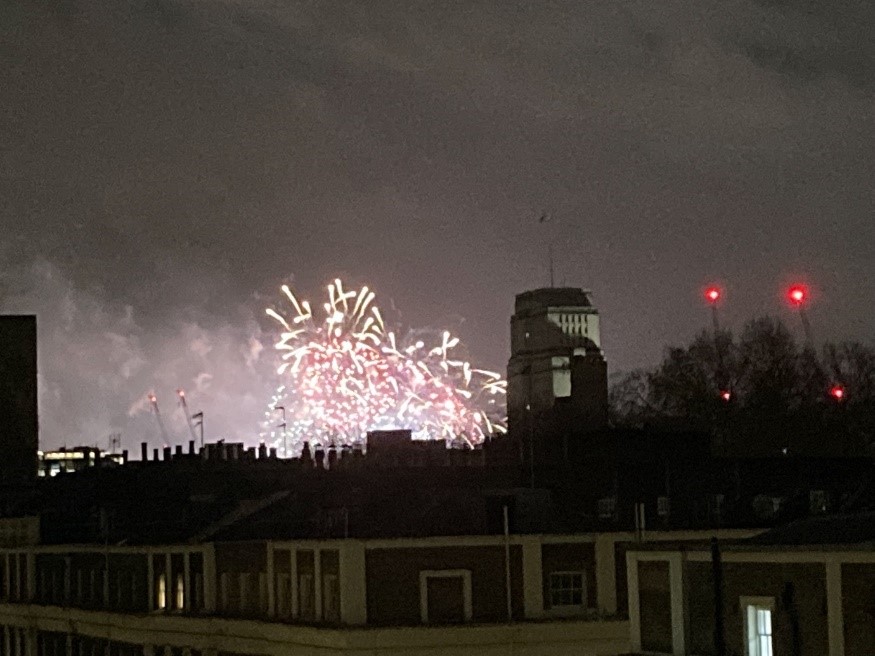
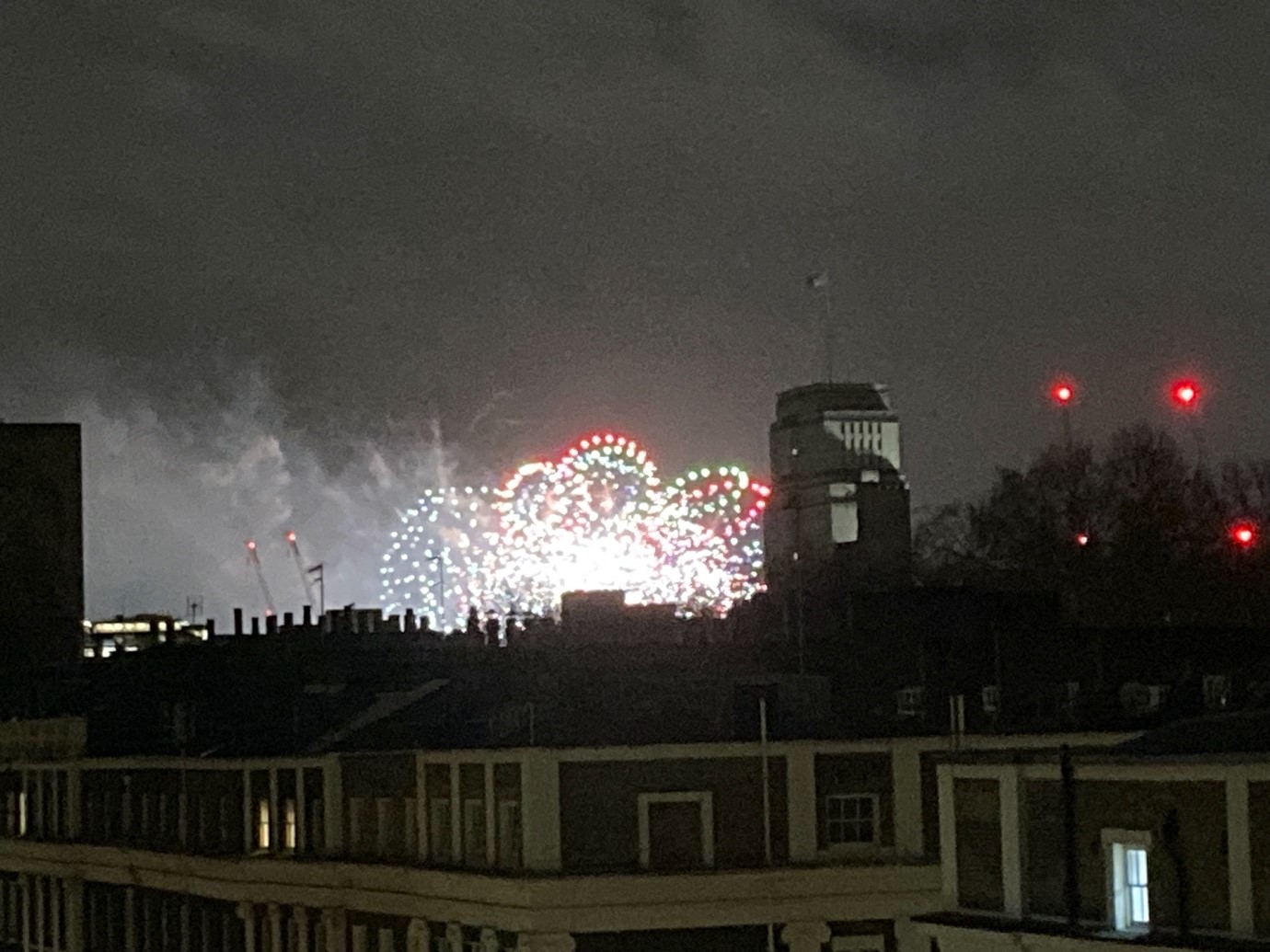
November Activity Report
30 November 2022
Global Japan Office Coordinator
Kazumi Taguchi
The November London report is about the Ura Matsuri 2022 festival which was planned and organised by the Ura Matsuri Collective which I am a member of.
In 2020 the Ura Matsuri Collective contributed to the Ura Matsuri in Japan Matsuri Online event organised by the Japanese Embassy in the UK. The last live Ura Matsuri was back in February 2019, and it has taken us 3 years 9 months to organise the latest which took place in November 2022. The Ura Matsuri team were very pleased to bring the whole festival together and entertain a London audience.
Ura Matsuri received a grant from Sasakawa Foundation as well as generous support and donations from Tazaki Foods, Yakult UK and Clear Spring and all this gave us huge encouragement. The Ura Matsuri Collective is very grateful for the support we have received.
Fortunately, the weather was fine, and it was relatively warm for a November evening: an absolutely perfect day for Ura Matsuri.
I had two tasks to accomplish, filming the event as the second film crew and performing on stage as a member of Frank Chickens. The photos shown of the event are taken from the video images.
There was a fascinating line-up of performers starting with Chindon-ya welcoming the audience at the gate. Yuko Tsubame and her musician played Okinawan music; Hibiki Ichikawa and his advanced students played Tsugaru Shamisen; Zashiki Warashi performed Japanese drum and flute; Kamura Obscura performed improvisational music with vocals; Akari Mochizuki and The Mochi band performed Japanese popular music; Beibei Wang and Mike played Chinese percussion; Mai and her musicians, Fear of Fluffing performed Butoh dance with experimental music; Tomoko Komura performed Benshi for a silent film with music and sound provided by Clive Bell; The Record of Living Being performed ambient music, and finally the event ended with Frank Chickens bringing the audience their original music from the 80s and 90s.
We had a lot of lovely feedback with people expressing how much they enjoyed the many different performances. This made it all worthwhile for the Ura Matsuri collective and we hope to use these responses as a reference when we organise the next event.
It was marvellous to share a really lovely time with a great audience and create an opportunity to communicate with London local people at a grass roots level by organising the event. Ura Matsuri is a place where different cultures and people come together. This event convinced me that it is very important to organise Ura Matsuri regularly in order to encourage and stimulate communication and understanding between East Asian culture as a whole and the local London community.
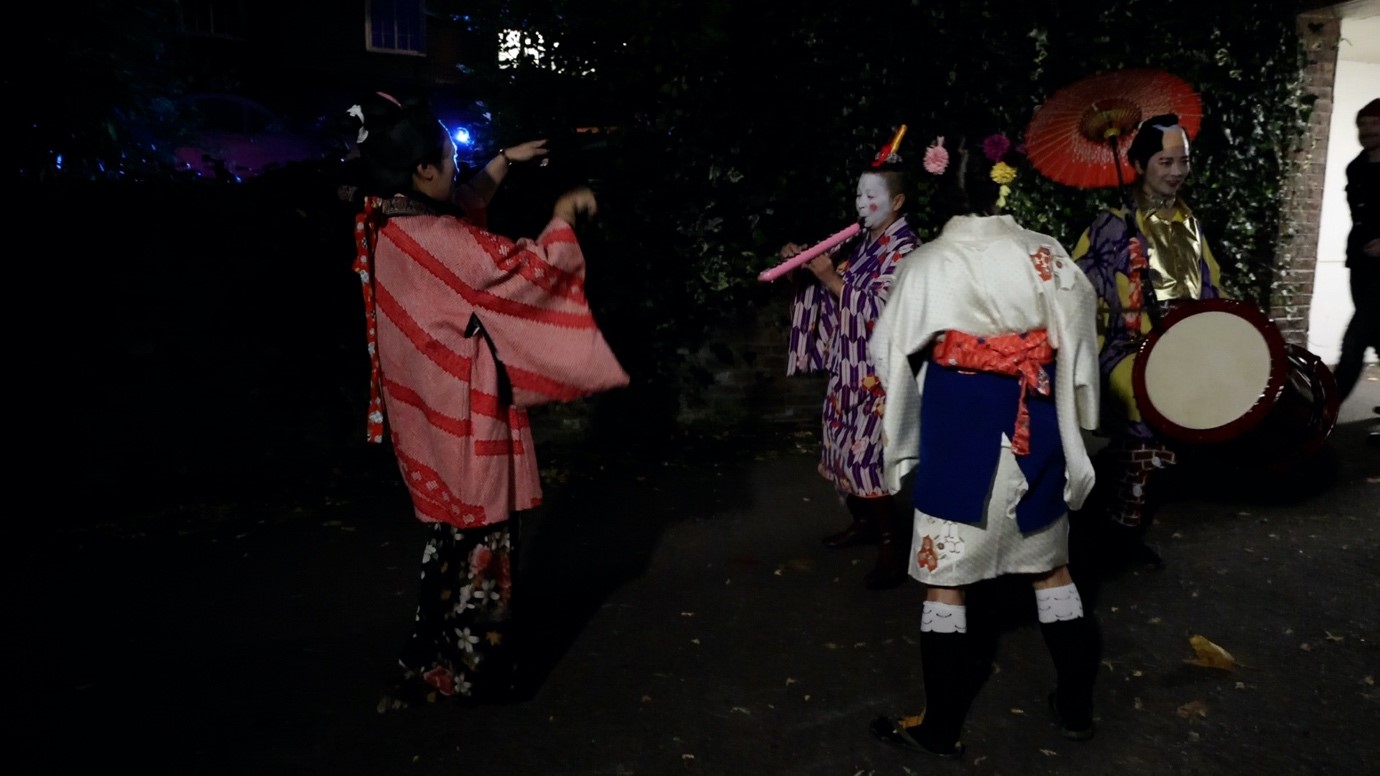
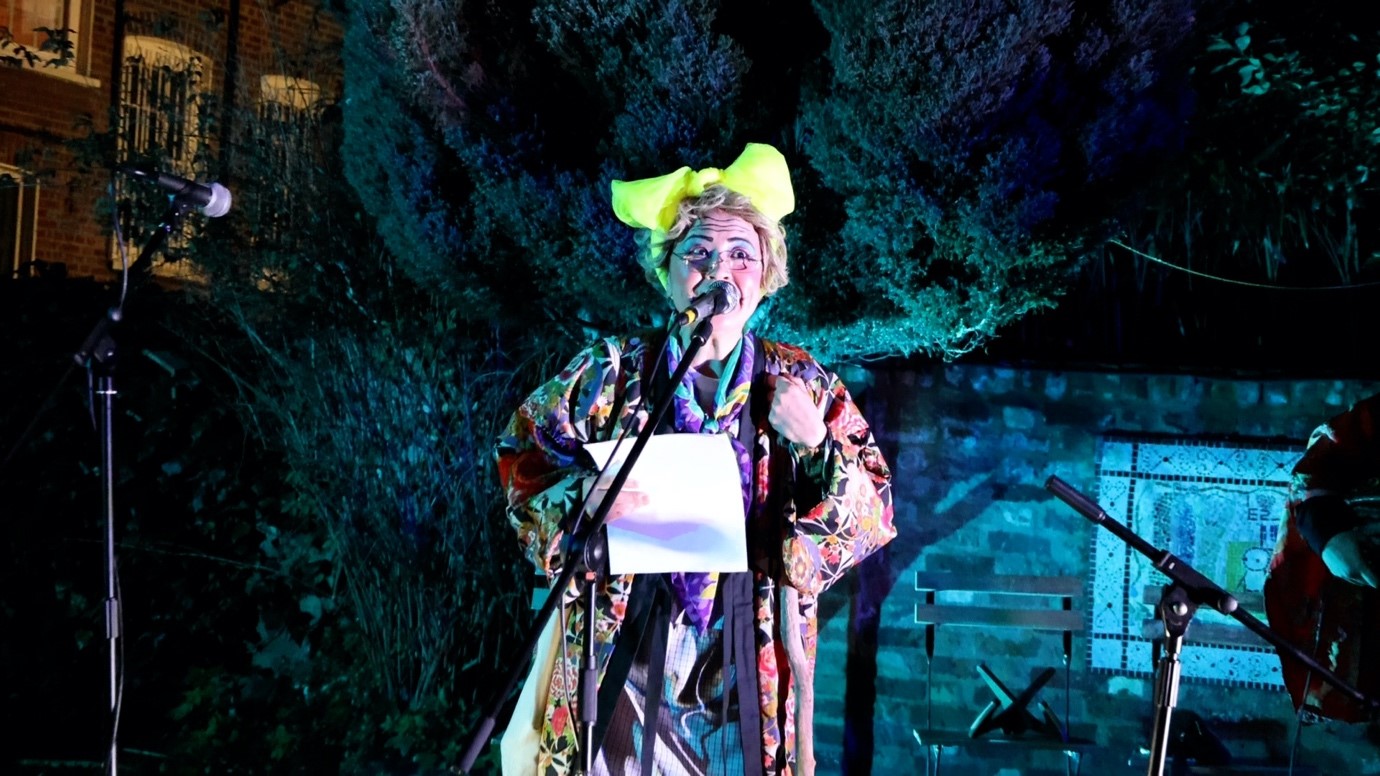
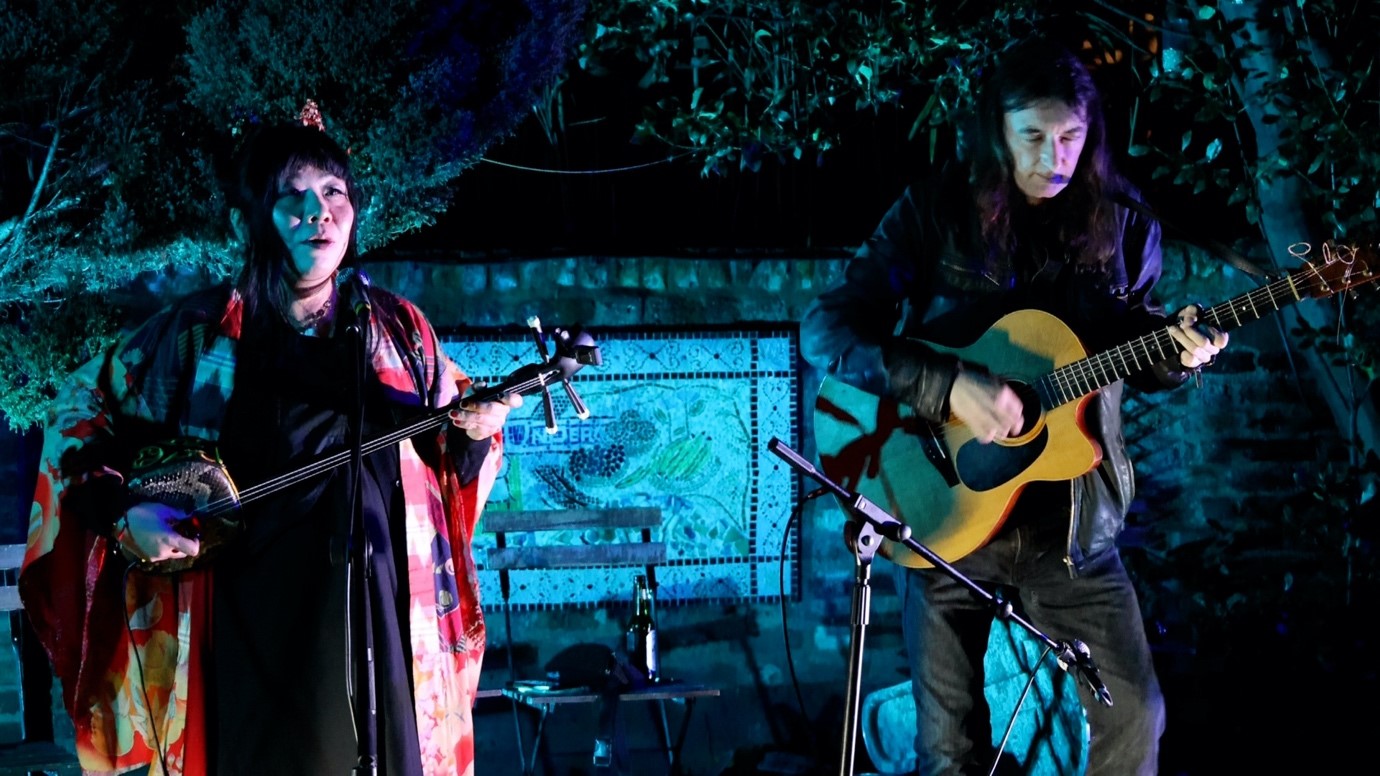
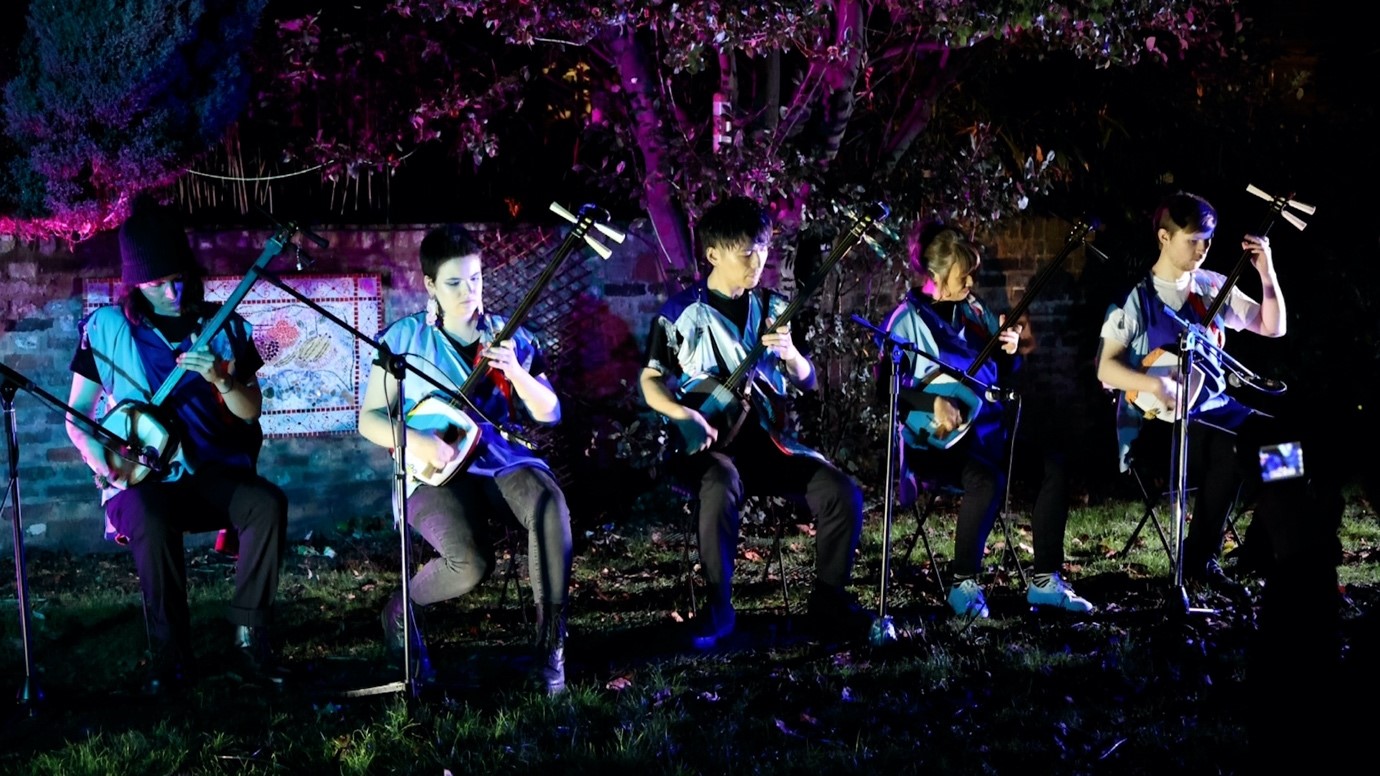
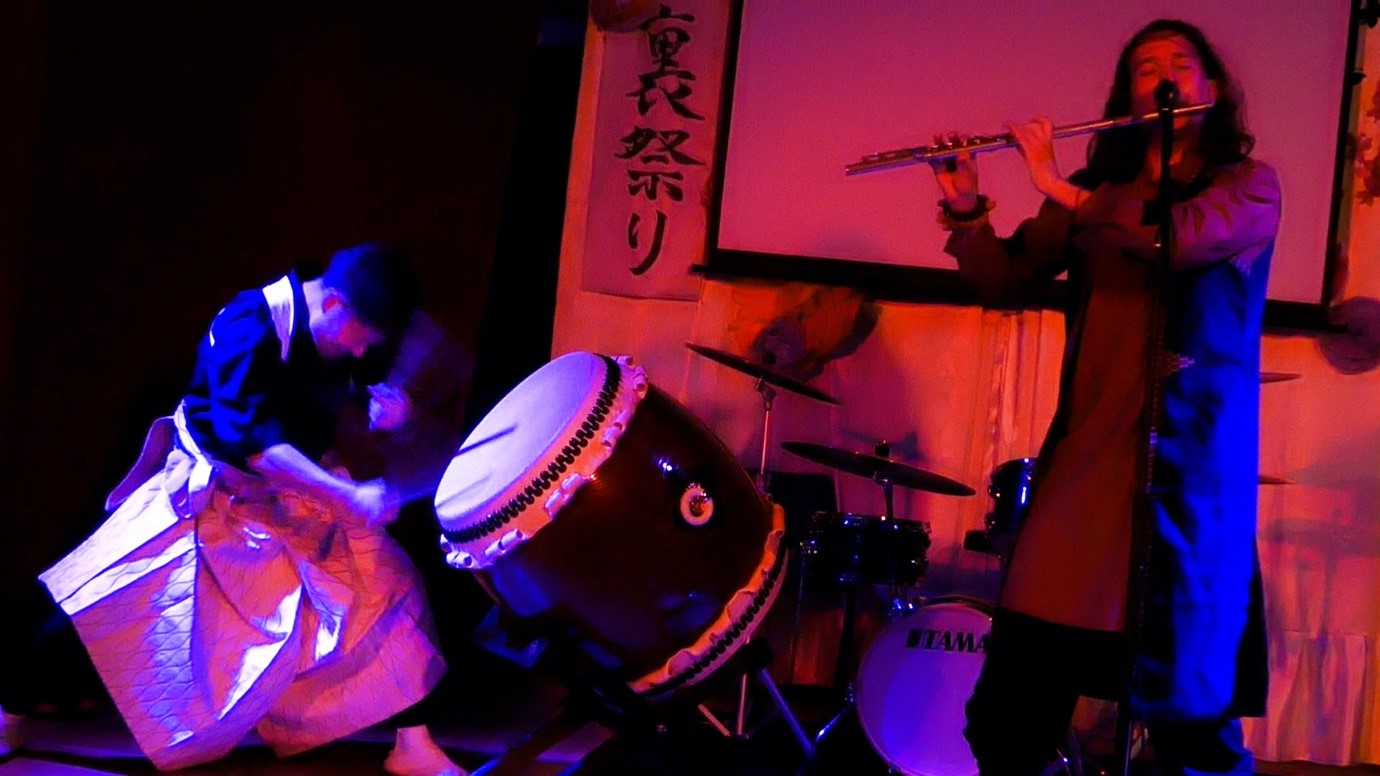
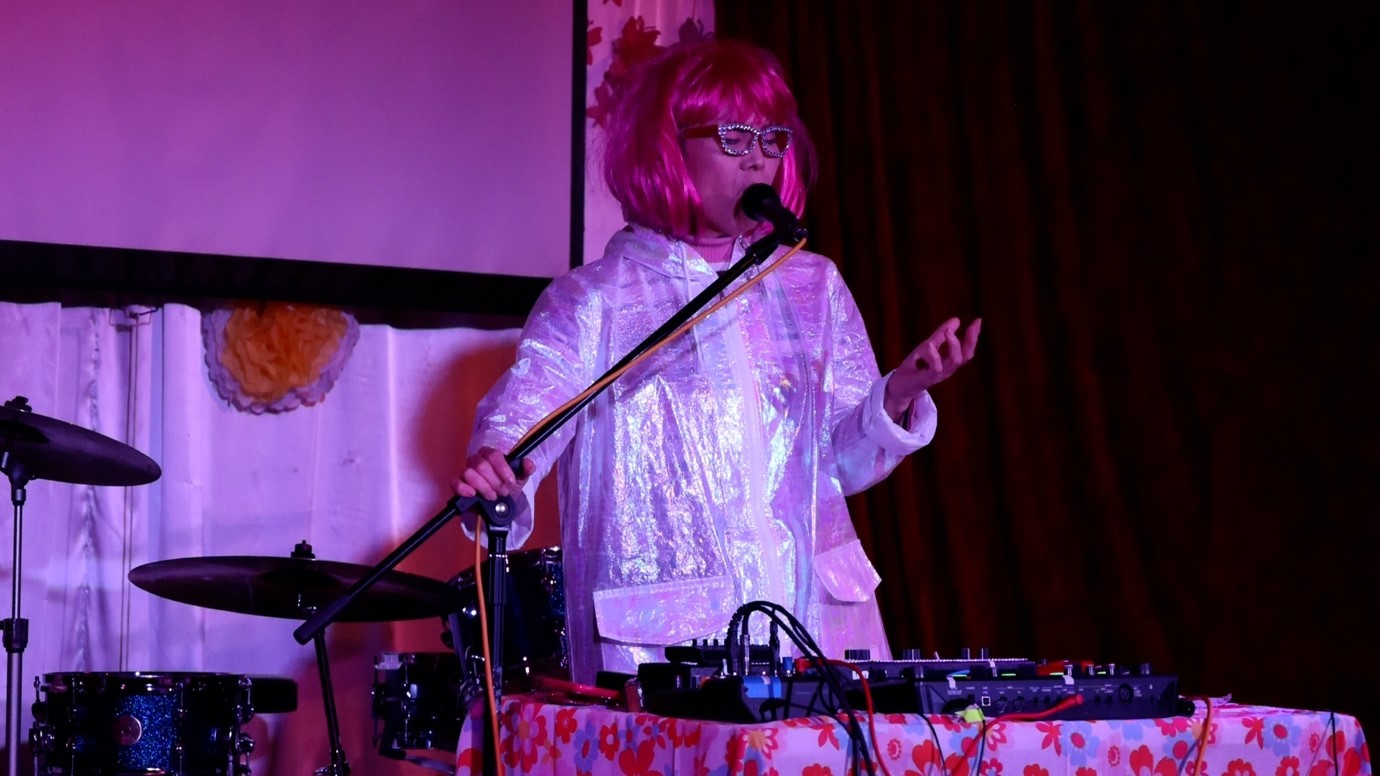
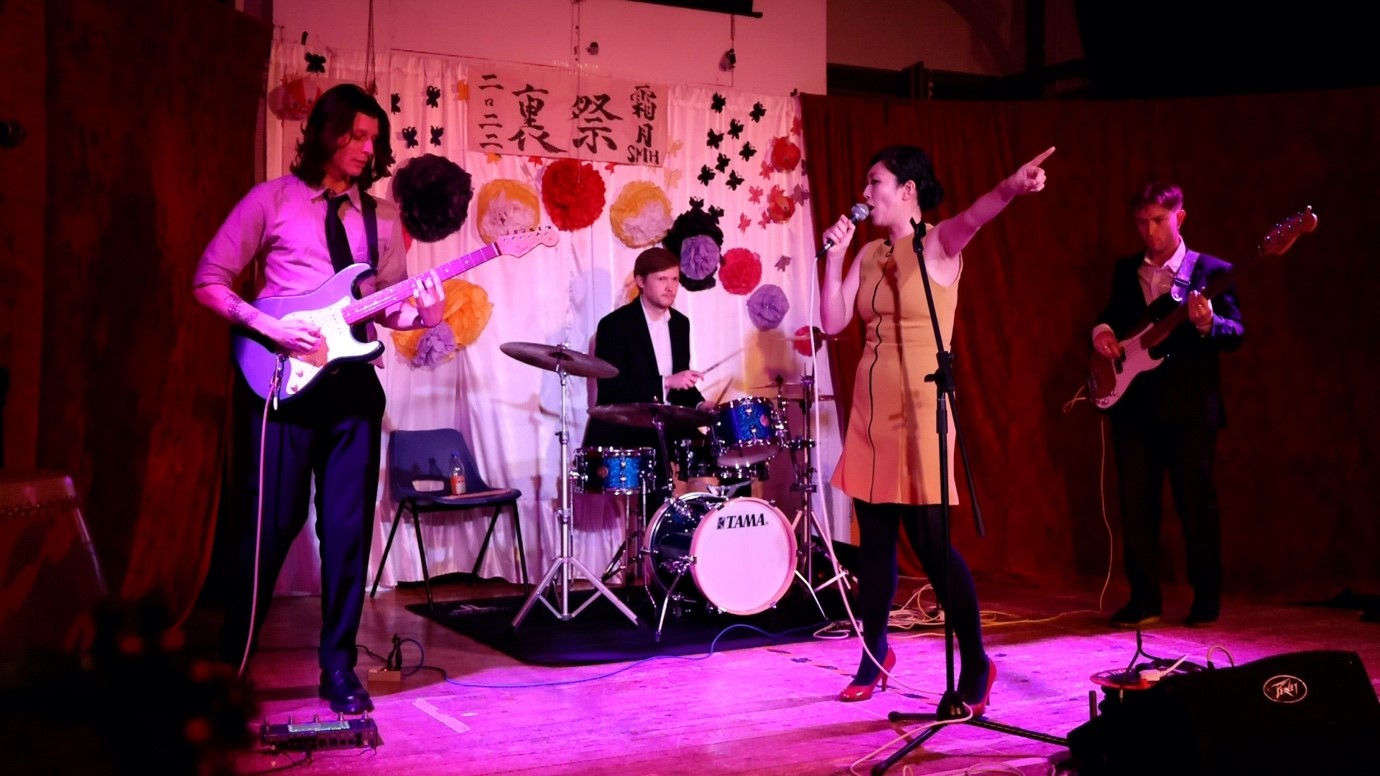
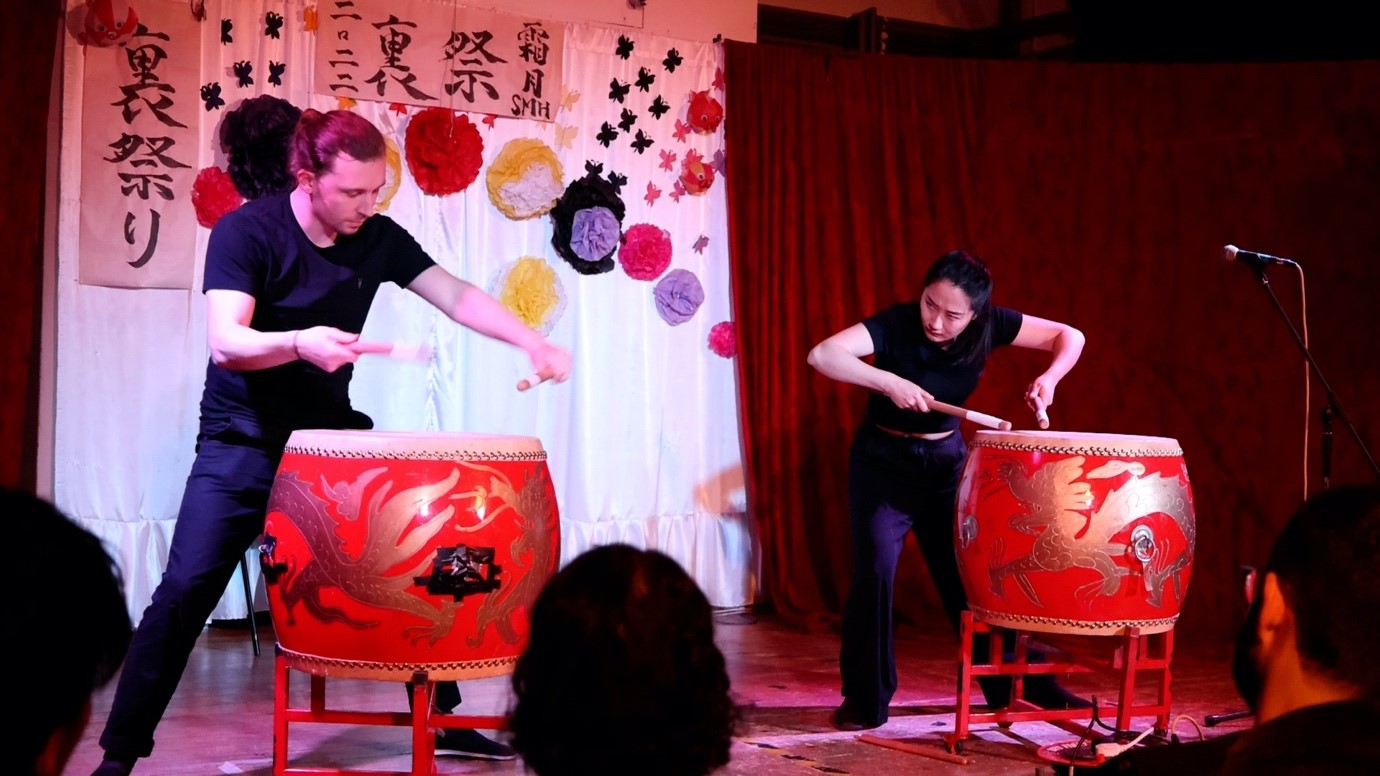
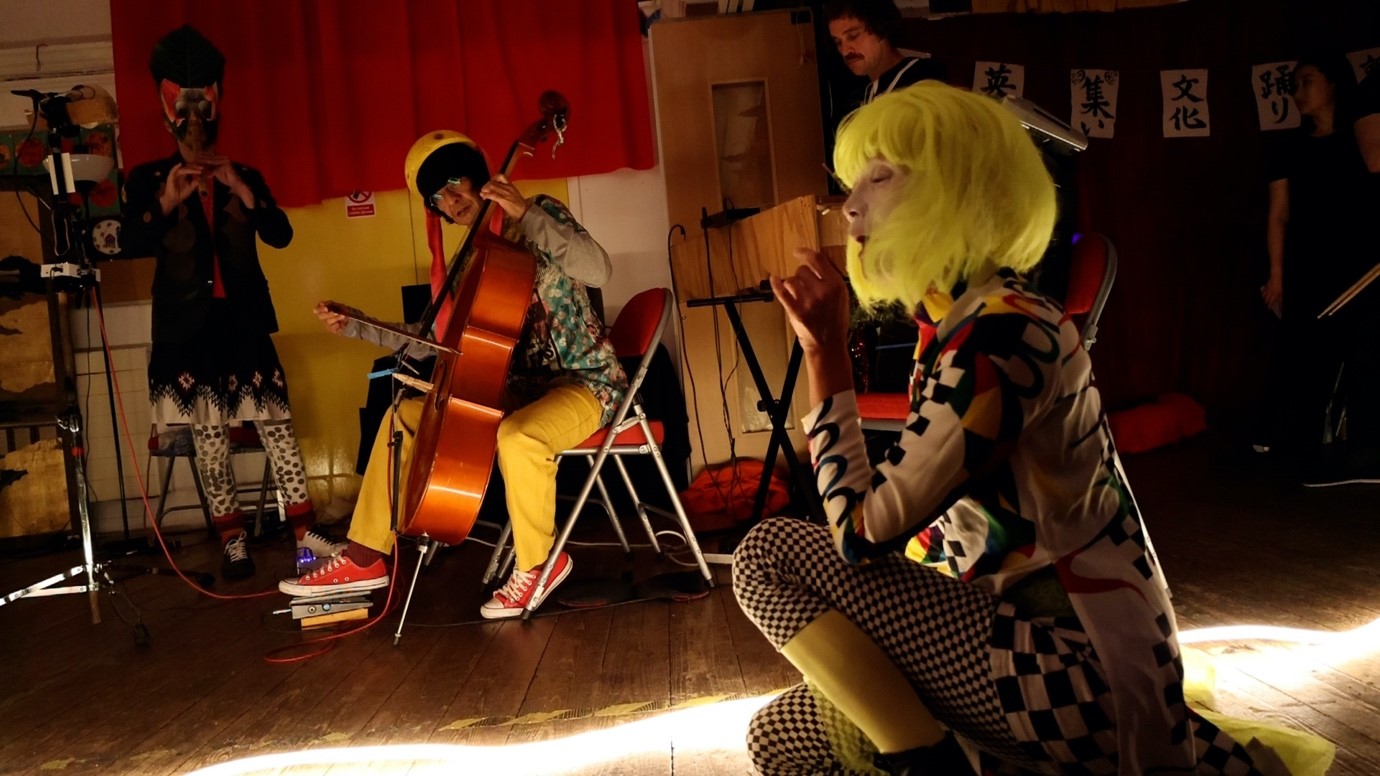
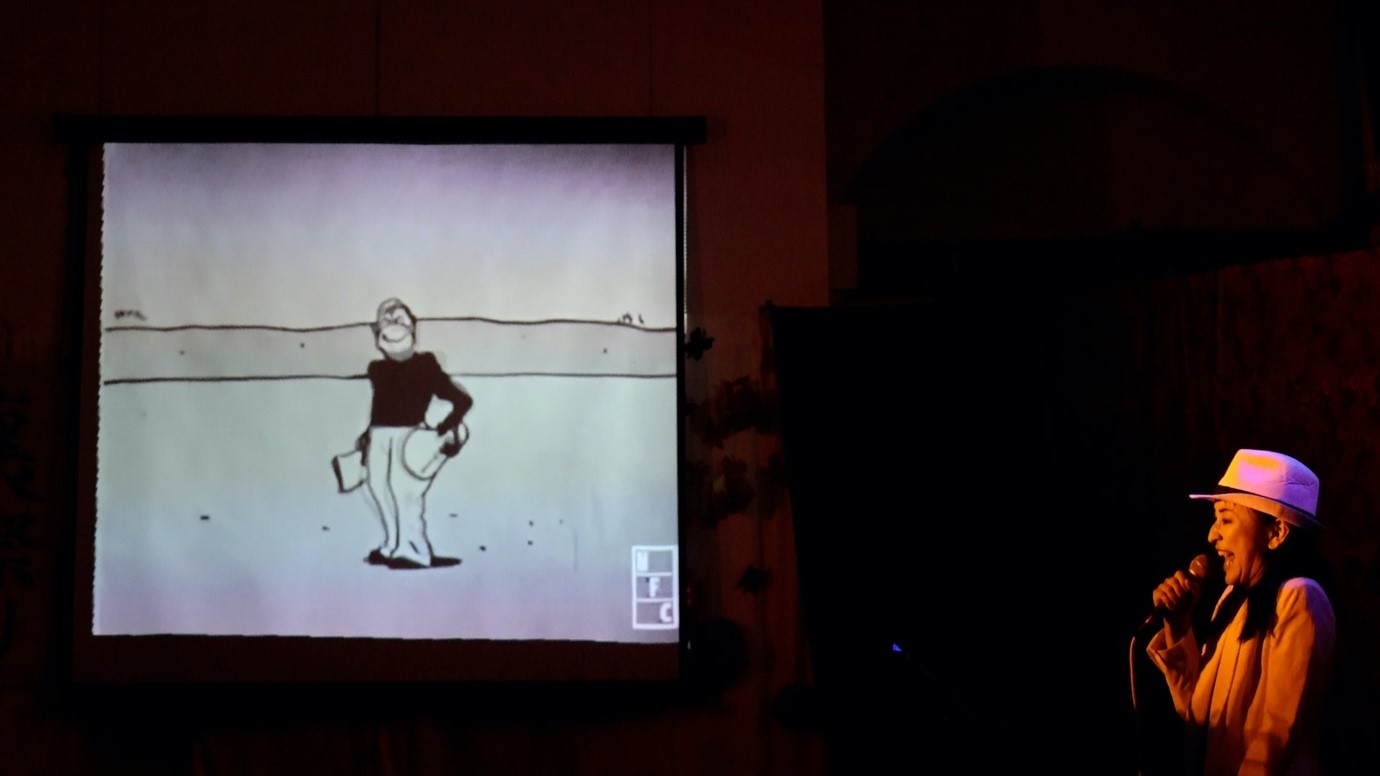
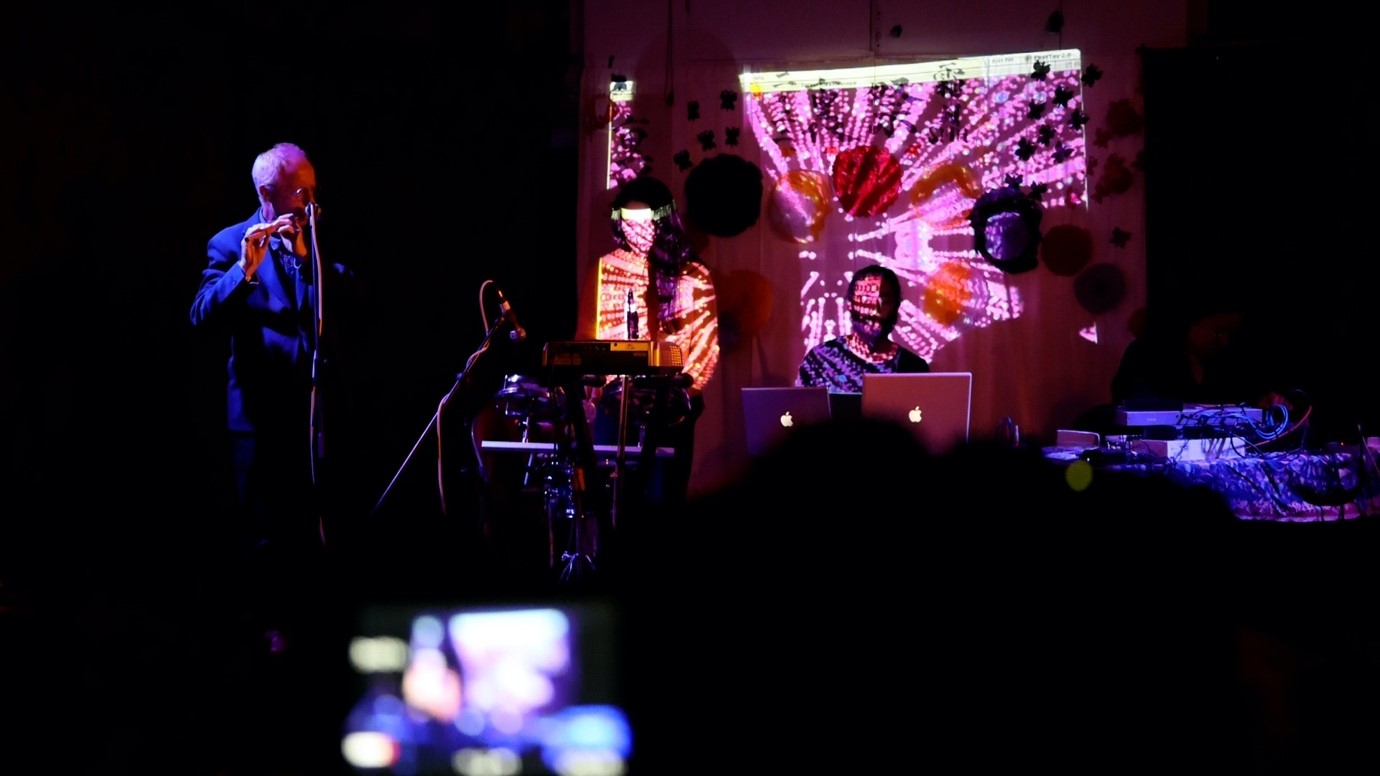
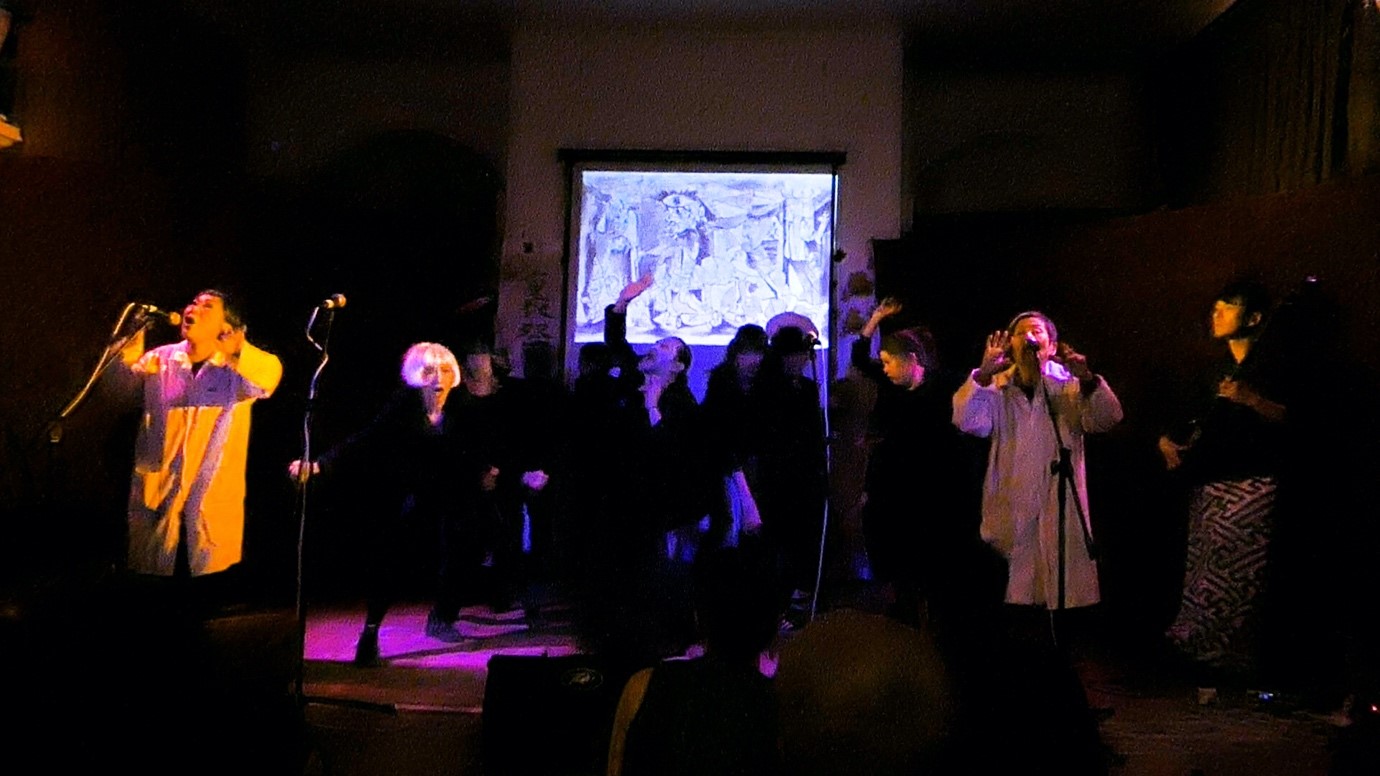
September Activity Report
30 September 2022
Global Japan Office Coordinator
Kazumi Taguchi
The September London Report is about the atmosphere in London at the end of the Elizabethan period and meeting up with a student, Nanako Nohara-san, who is starting a year abroad at SOAS this Autumn and currently attending English courses to prepare for her studies.
The Queen had her Platinum Jubilee earlier this year, celebrating 70 years of service to her citizens. Nobody imagined she would pass away so suddenly a short time later in September.
No matter whether you are a royalist or not, people in the UK were shocked by the sudden news of the Queen’s death.
I would like to show how the Queen’s death was received on the streets of London.
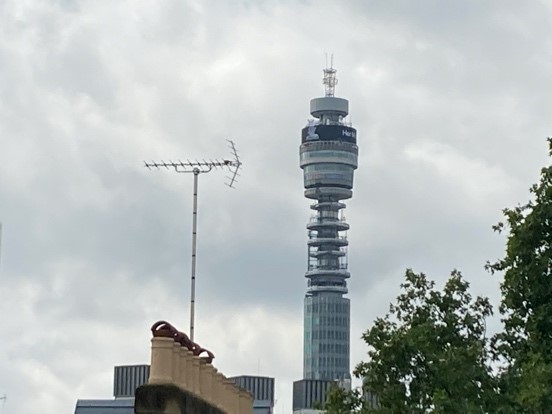
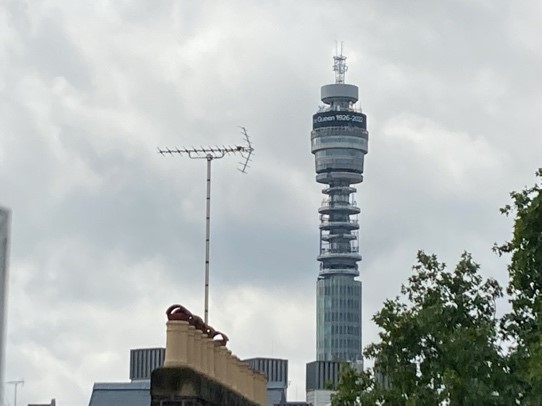
BT Tower, a London landmark, shows a tribute to the late Queen Elizabeth
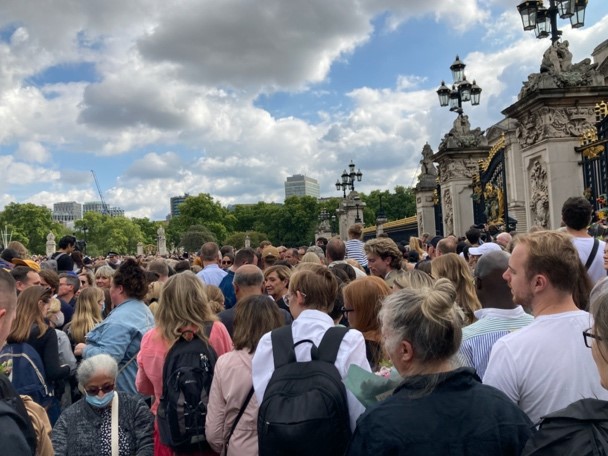
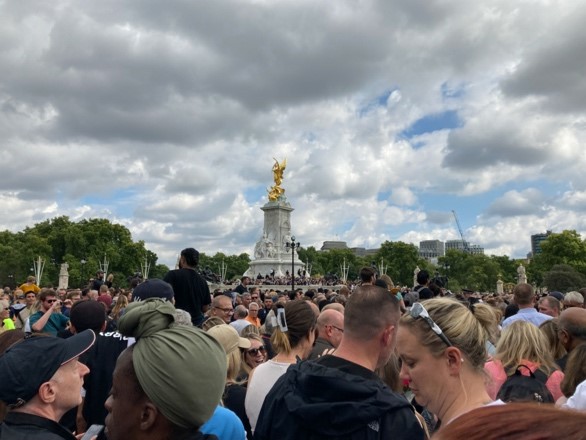
People gathered in front of Buckingham Palace
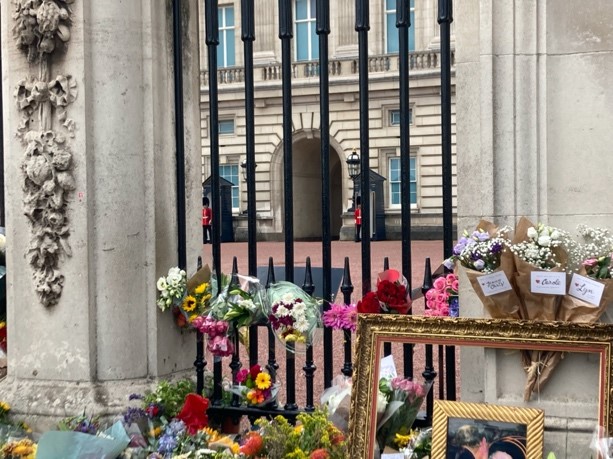
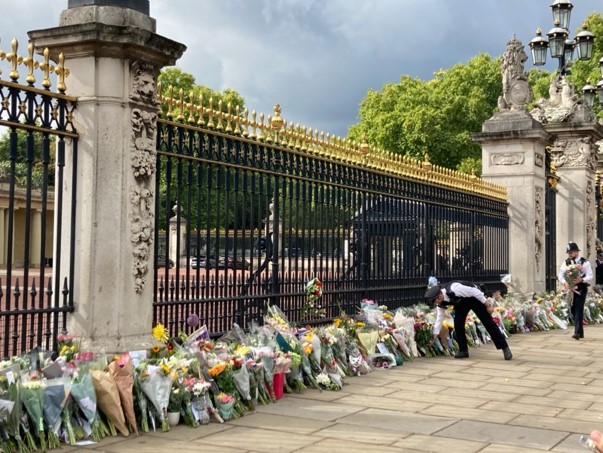
Flowers for the Queen displayed at the entrance gate of Buckingham Palace
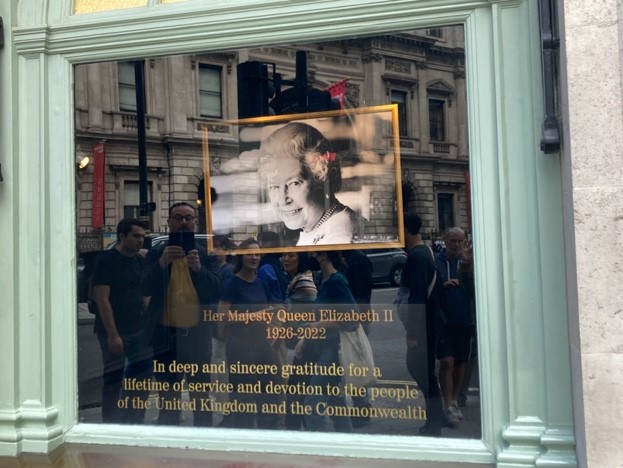
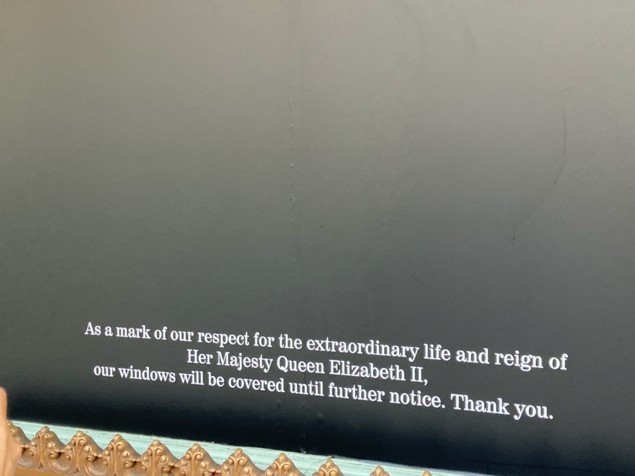
Fortnum & Maison showed a tribute to the Queen and closed their window display during the mourning period
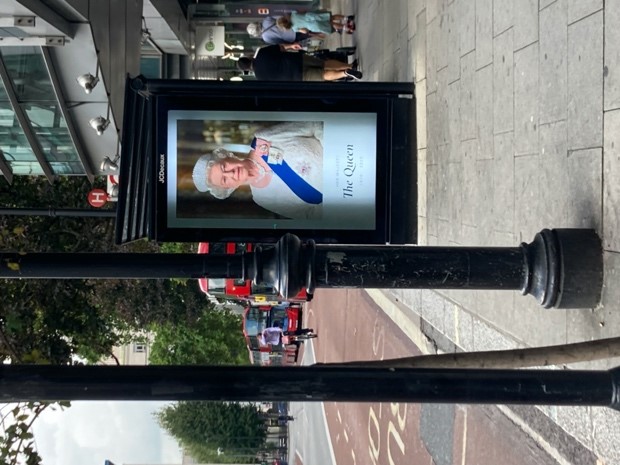
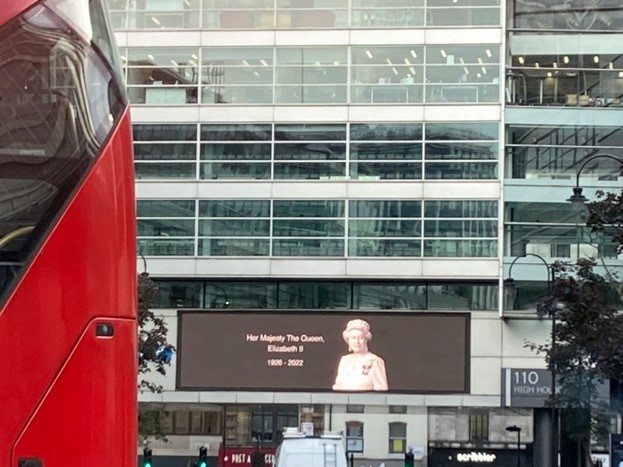
The Queen’s image displayed all over London
The second item in my report is about a meeting I had with a student, Nohara-san, who arrived in London in September to start a year abroad at SOAS.
Nohara-san is staying in International House which is student accommodation provided by the University of London. She told me that there had been many events and activities organised to help students meet and get to know each other.
We had a little walk along a nearby canal and chatted for a while. She was excited about coming to London to study and said she was looking forward not only to her academic studies but also to enjoying all the cultural activities and events London has to offer.
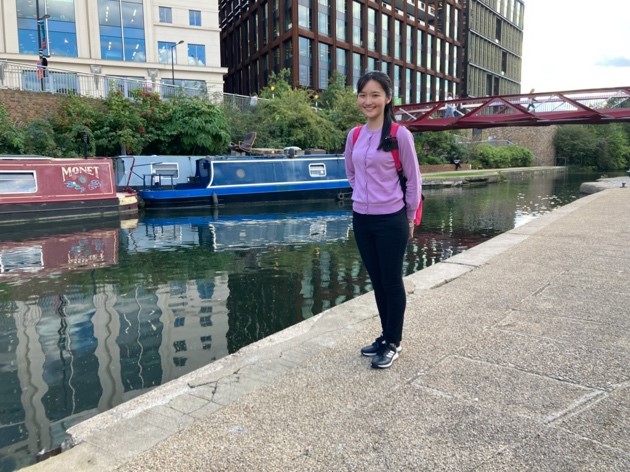
Nanako Nohara-san at the canal near Kings Cross
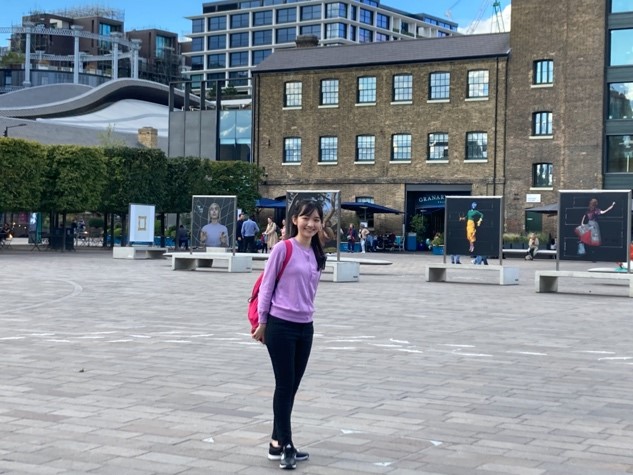
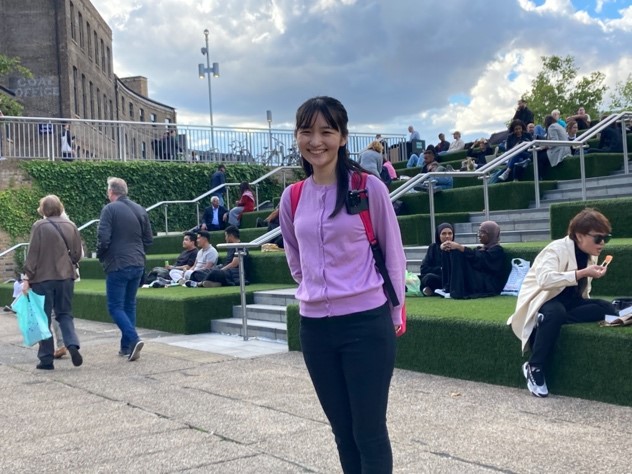
August Activity Report
31 August 2022
Global Japan Office Coordinator
Kazumi Taguchi
The July London Report is about my impression of watching a 1960s special effects movie classic, “Mothra” which was show at London’s art centre, Barbican.
There are many Japanese film nights at Barbican but this time it was a special event because the film was projected outdoors on the third floor of the building at 8pm in the evening.
Right next to the square where the cinema was shown is the tropical room which is a permanent installation. There are many tropical plants displayed there and it is a fantastic environment surrounded by all sorts of exotic greenery. I had entered into a jungle, into the world of “Mothra” even before the film started.
There is a block of apartments above the Barbican centre and many people live there in flats. So, we used headphones to listen to the film in order not to disturb the neighbourhood. We watched the movie on a gigantic inflatable screen displayed in front of the audience.
I was really thrilled and looking forward to viewing “Mothra” on a gigantic screen out in the open-air, and my expectations were not betrayed. With the fantastic special effects and beautiful singing and harmonies from the twin duo, ‘The Peanuts’, I was totally mesmerised and the two hours quickly passed by.
There was a big audience gathered together to enjoy watching Mothra, and when the film ended, we all applauded a great film and felt sad that a magical Summer Night’s Dream had ended. I felt that people in the UK were really good at planning an event like this and offering people a wonderful romantic experience!
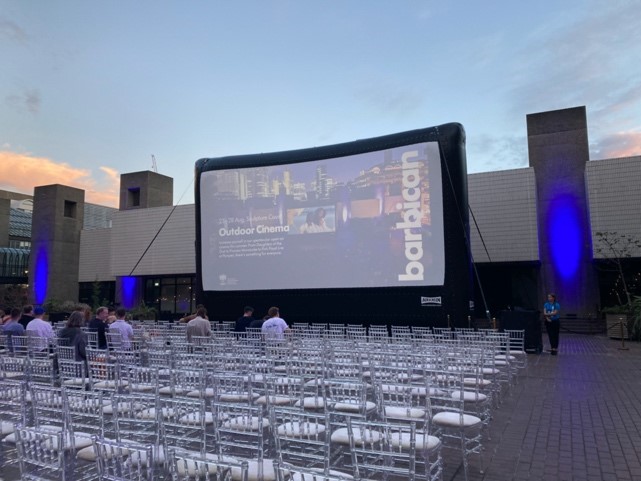
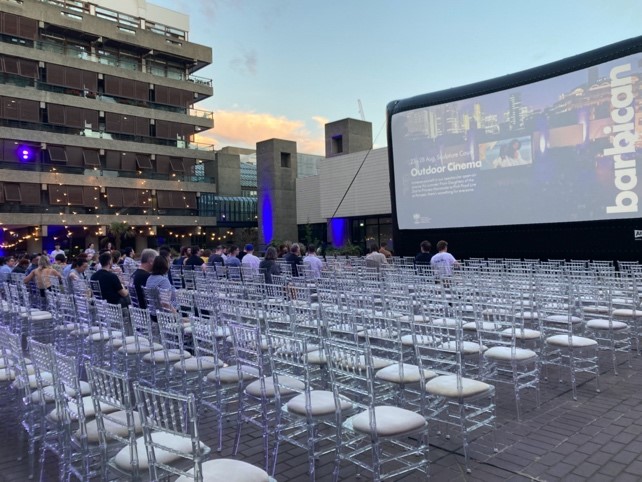
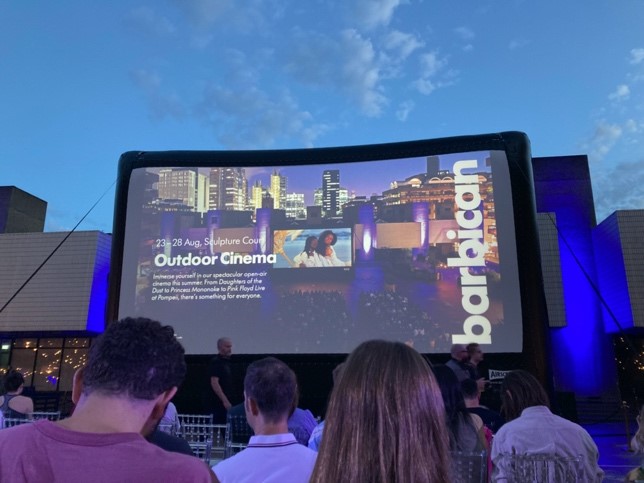
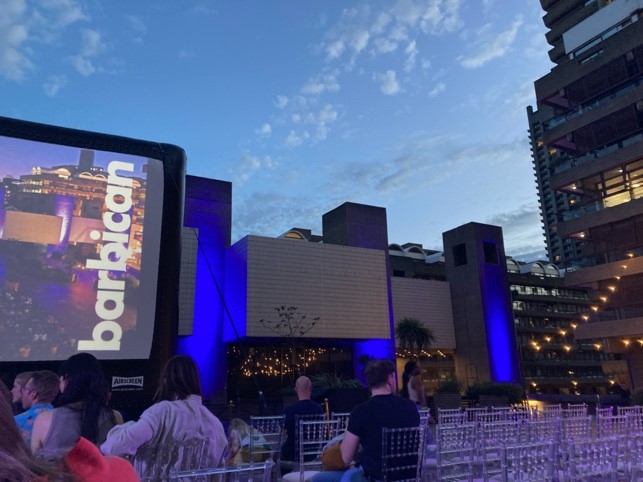
The location on the third floor of the Barbican where the film was shown on an inflatable screen
July Activity Report
31 July 2022
Global Japan Office Coordinator
Kazumi Taguchi
The July London Report is about my personal experience of contracting Covid at the beginning of the month and the record-breaking hot weather experienced in the middle and southern parts of England when the temperature reached 40 degrees centigrade.
At the end of June after the Noh event had finished, I was feeling well and full of energy. However, a few days after visiting the Royal Opera House to see Madame Butterfly, I started to feel very tired. This symptom of feeling run down worsened, so, I decided to give myself a Covid swab test. The result was positive.
In the UK, the rule is that you must go into self-isolation for five days if you test positive for Covid. I remember that I felt a burning hot sensation below the shoulder. This symptom was followed by a high temperature, a cough, and extreme tiredness. As a result, I was unable to get out of my bed for a couple of days.
I began to recover gradually. But then when I started to feel better, some symptoms returned, and I felt weak again. In all the whole process went on for nearly two weeks. After five days of self-isolation, I still had a positive result, and that went on for another week until after twelve days, I finally got a negative result.
Now, I am recovered and well again. However, I am very aware Covid is still around and I need to be careful all the time to avoid contracting it again.
After recovering from Covid, I started to relax a little. Then, suddenly the weather in England became extremely hot reaching the highest temperature in the history of the country: over 40 degrees in some areas.
Summer in the UK is usually pretty bearable. There is no need for an air conditioning system and very little humidity in the air. When the temperature nearly hit 40 degrees for four days, even without humidity in the air a lot of people felt dizzy and uncomfortable. The government and local governments warned and advised people not to go out unless necessary and if they had to go out, to drink plenty of water.
There are no travelling restrictions this year, and many people have planned to go away on holiday. London is jam-packed full of tourists this summer.
These photographs were taken at the canal in Camden showing people enjoying the spectacular, fun fountains and enjoying the screening of free films along the canal.
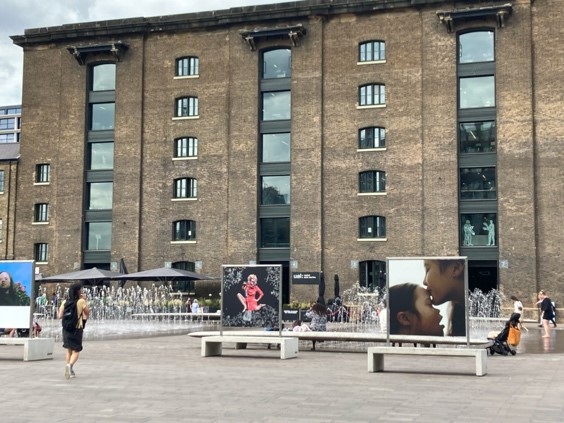
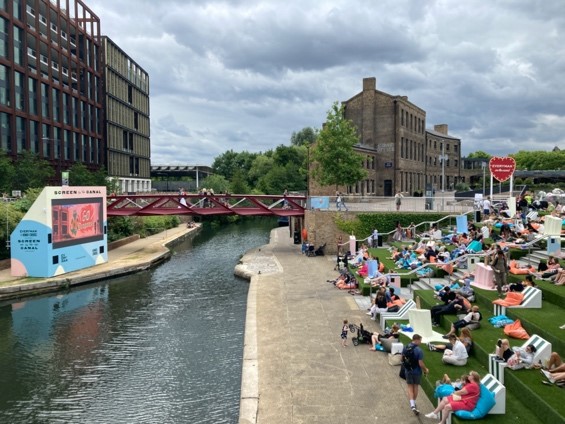
June Activity Report
30 June 2022
Global Japan Office Coordinator
Kazumi Taguchi
The June London Report is about the Noh event which took place at Kings Place in London from the 24th to 25th of June.
This event ‘Noh Reimagined’ was organised and produced by Ms. Akiko Yanagisawa of the International Noh Project and went under the title, ‘Spirits of Flowers’.
Day one began with a talk given by the Hosho School of Noh Shite actor, Sano Noboru sensei. The talk was followed by a performance of “Wisteria”.
The second day saw events running throughout the day. The morning began with a Noh movement workshop, then came a modern interpretation of the Noh play, “Simida River” in sign language. Next there was a talk given by Professor Gerstle, and this was followed by a dance performance by the contemporary dance duo, Thick & Tight who have studied Noh and Kyogen movements. The final event of the day took place in the evening and featured a classic Noh play “Kurozuka” in a performance which included contemporary dancers and music.
I had the privilege of standing in for Dr. David Hughes and interviewed and interpreted a talk given by Sano Noboru sensei. At the beginning, I was a little nervous but I gradually got in the swing of things and managed to recover my rhythm in the second half as I focused on delivering what Sano sensei wanted to pass on to the audience.
The finale of the talk had a mini chanting workshop with the audience which featured the audience attempting a few phrases of Hagoromo (Angel) following Sano-sensei’s instruction. Everyone seemed to enjoy the experience of chanting together and in the end I was pleased with how the event had gone.
Many people in the UK are fascinated by the history and culture of world theatre. Indeed, there were so many people interested in the Noh event that tickets for the first day were sold out a long time before the performance date.
The performance of Wisteria received a great reception from the audience and the Noh players responded with a marvellous encore. It was a fantastic evening. We had been taken to an extraordinary space away from everyday life: it was a mesmerising and uplifting experience.
I learnt a lot while participating in Sano sensei’s talk and one of the things I learnt is “Mokuzen Shin’go”. This is a theory related to performing art from the legendary 14th-15th century Noh theatre director, writer, actor, Zeami.
According to the explanation given by Sano sensei: one can check how one looks in front with your own eyes but you have to check the back of your body with the mind. If you are aware of your back, your back will look fine. The important factor is the awareness involved.
Another point I learnt is that Noh is not an entertainment. At the base of all the Noh plays, there are themes such as “World Peace”, “National Tranquillity”, “Bountiful grain harvest” and “Prosperity of descendants” and these are the important themes and concepts that Noh is transmitting to the world.
I had a chance of observing the Noh movement workshop on the second day: another popular event which was also sold out. All age groups attended this fascinating occasion and everyone thoroughly enjoyed and enthusiastically participated in learning Noh movements as taught by Sano sensei.
Sano sensei’s teaching method was wonderful. He taught the beginners the basic Noh posture, Noh suriashi walking, the foot movements, expression of crying, the series of movement of ‘beautiful me’ ‘feeling sad, ‘different me’, ‘seeing the ghost’ and ‘going to beat the ghost’. In a short period of time, students had a rich insight into the experience of Noh movement and they all looked happy after the class as readers can see by checking the photos of the workshop below.
Overall, a thoroughly entertaining, informative and enjoyable two days.
Ryota Imamura san who is studying a year abroad at SOAS volunteered for this Noh event. He’s coming to the end of his stay and made the most of that time by contributing to promoting Japanese culture overseas.
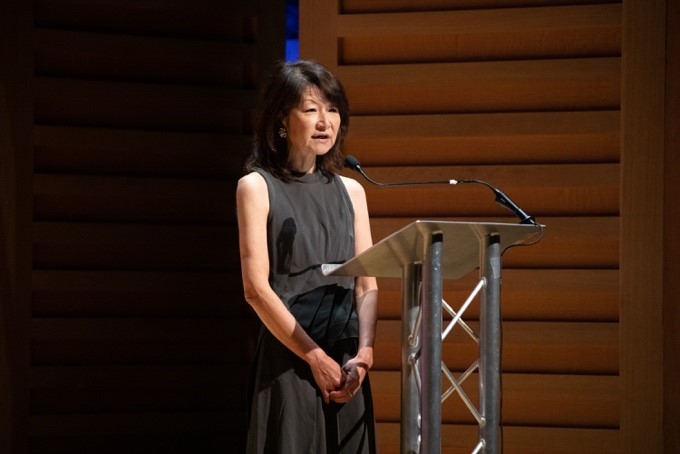
Noh Event organiser, Ms. Akiko Yanagisawa
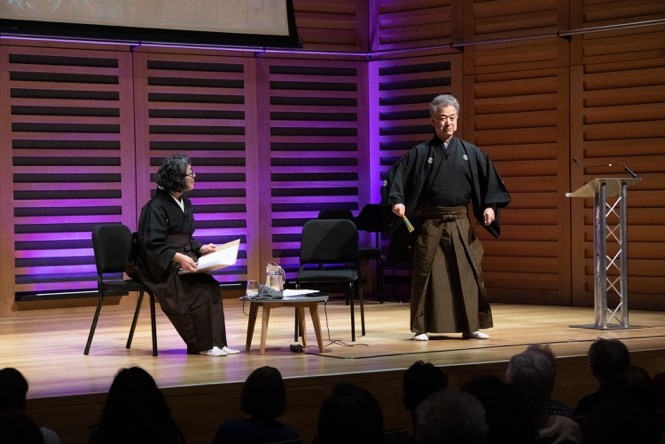
A moment during Sano-sensei’s talk
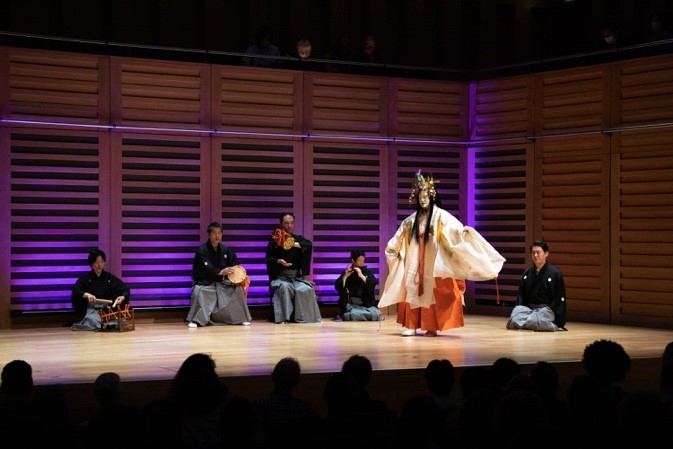
Noh Performance, Wisteria
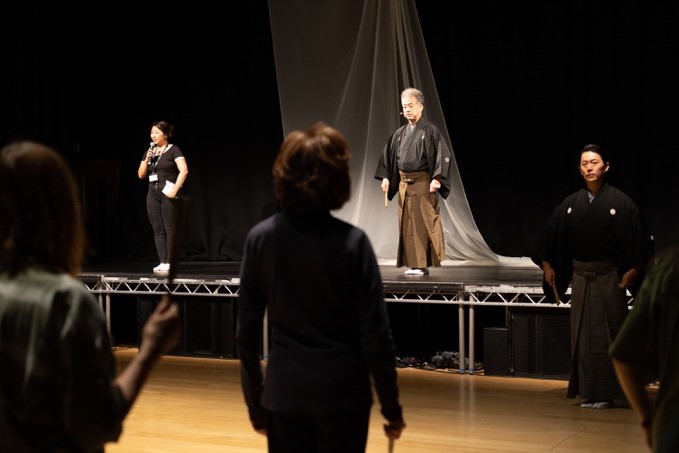
Noh workshop
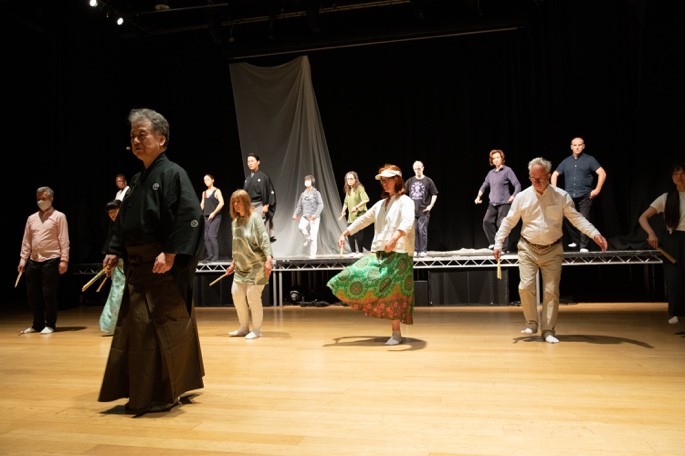
Noh workshop
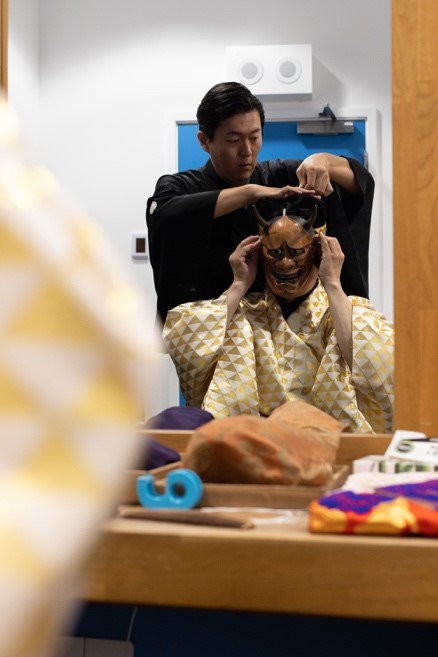
In the Mirror room
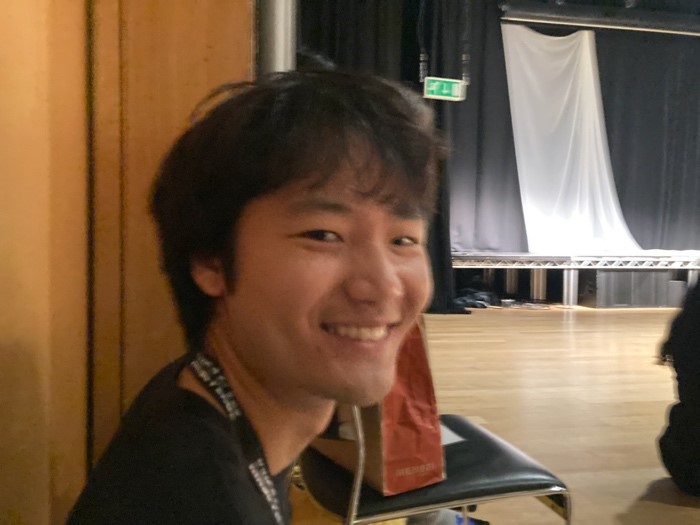
TUFS’s year abroad student, Ryota Imamura san who volunteered for the Noh event before his return to Japan
(Photo: by the writer)
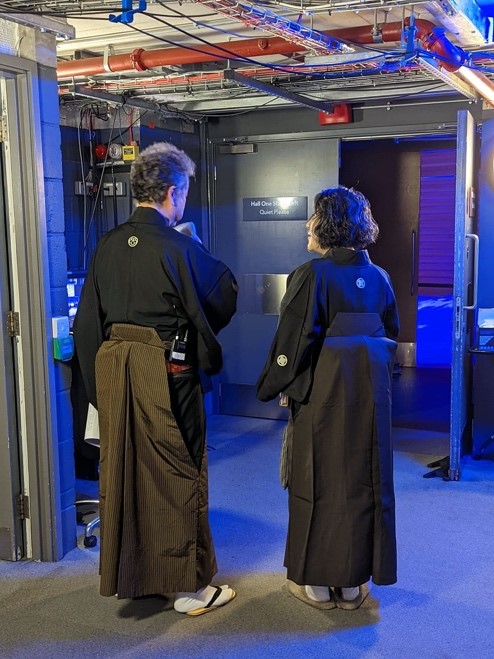
Shite actor, Sano Noboru sensei & my good self
(Photo: Kimono Costumer, Mamiko Sato of Kimono-de-Go)
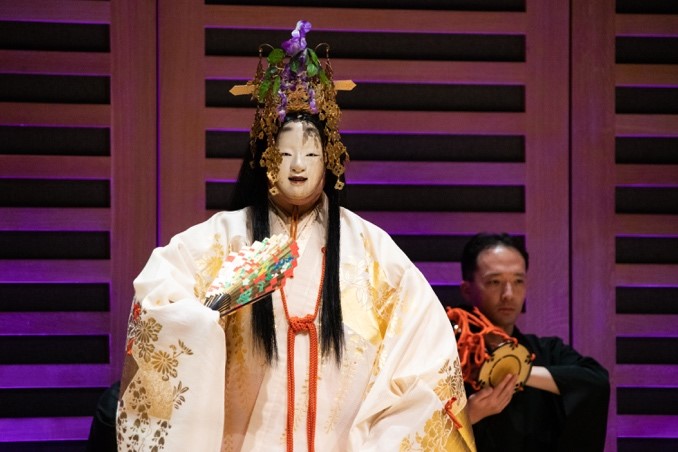
Noh Performance, Wisteria
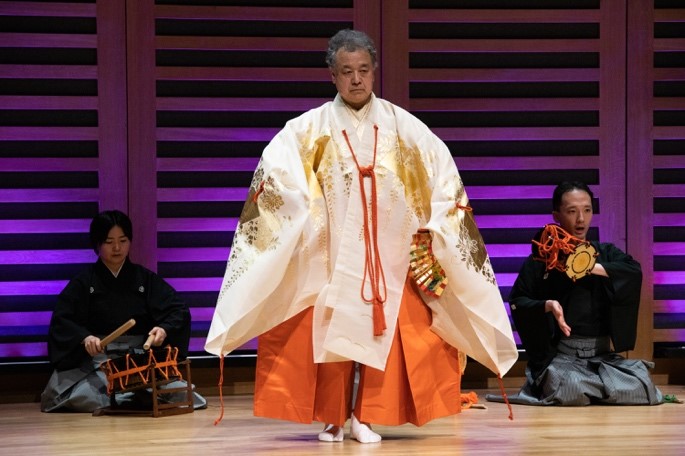
Encore
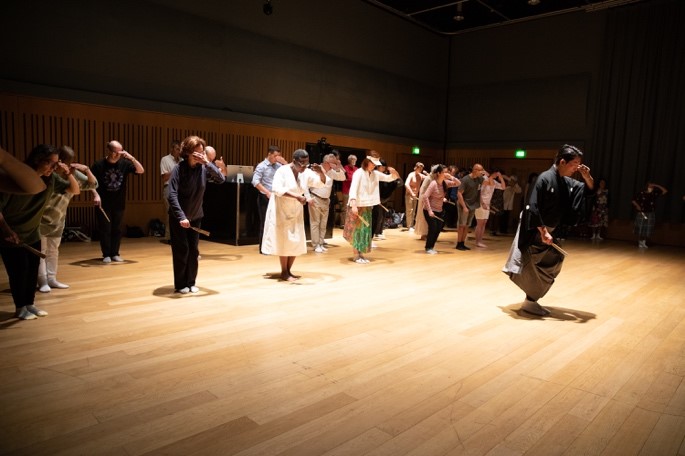
Noh workshop
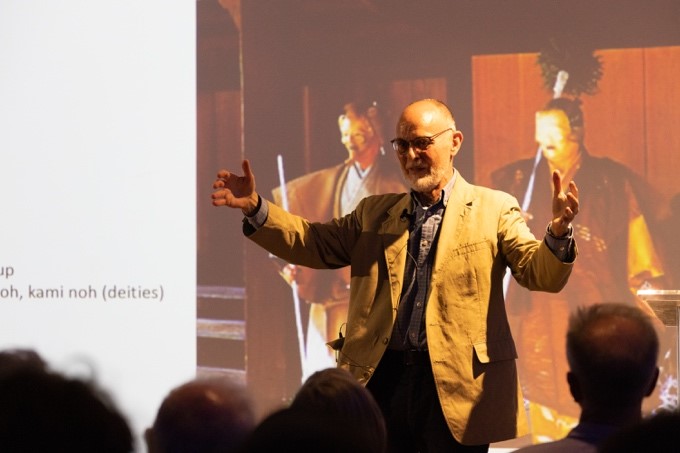
Professor Gerstle’s talk on Noh
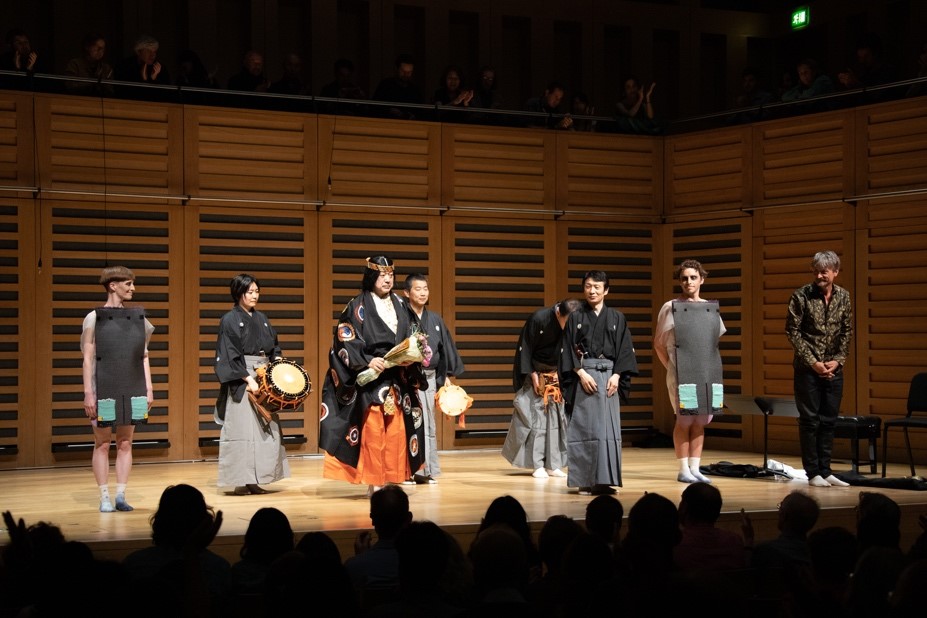
Finale of the 2nd day performance
*All the photos except two were taken by the photographer, Mayumi Hirata with the courtesy of the International Noh Project.
May Activity Report
31 May 2022
Global Japan Office Coordinator
Kazumi Taguchi
The May London Report is about the Elizabeth Line which is the new suburban and urban railway service connecting East and West London and the surrounding areas. The opening of the line was delayed many years and it was finally officially inaugurated in May.
The nearest station to SOAS on the Elizabeth line is Tottenham Court Road. Currently, there is no direct connection to Heathrow, but you can change trains on the same line at Paddington. Altogether, the journey takes only 42 minutes which is remarkably fast. It’s the birth of a very convenient line indeed. It is the 70th anniversary since Queen Elizabeth was crowned and a very fitting tribute.
I was fascinated and excited about using the line for the first time. I got on the train at Tottenham Court Road heading East toward the Docklands which has become an important economic region in recent years.
In order to get to the platform of the Elizabeth line, one has to go deep down into the underground. The whole new construction and line is very spacy and is in many ways reminiscent of an airport shuttle station. It is very futuristic and clean overturning the stereotypical image of the old London tube system.
The East of London experienced large-scale development at the time of the London 2012 Olympic Games. I decided to ride to Custom House where there is a big exhibition hall called ExCel. It took only 17 minutes from the centre to get to the old London dockside area. A journey that used to take over an hour and involved changing lines.
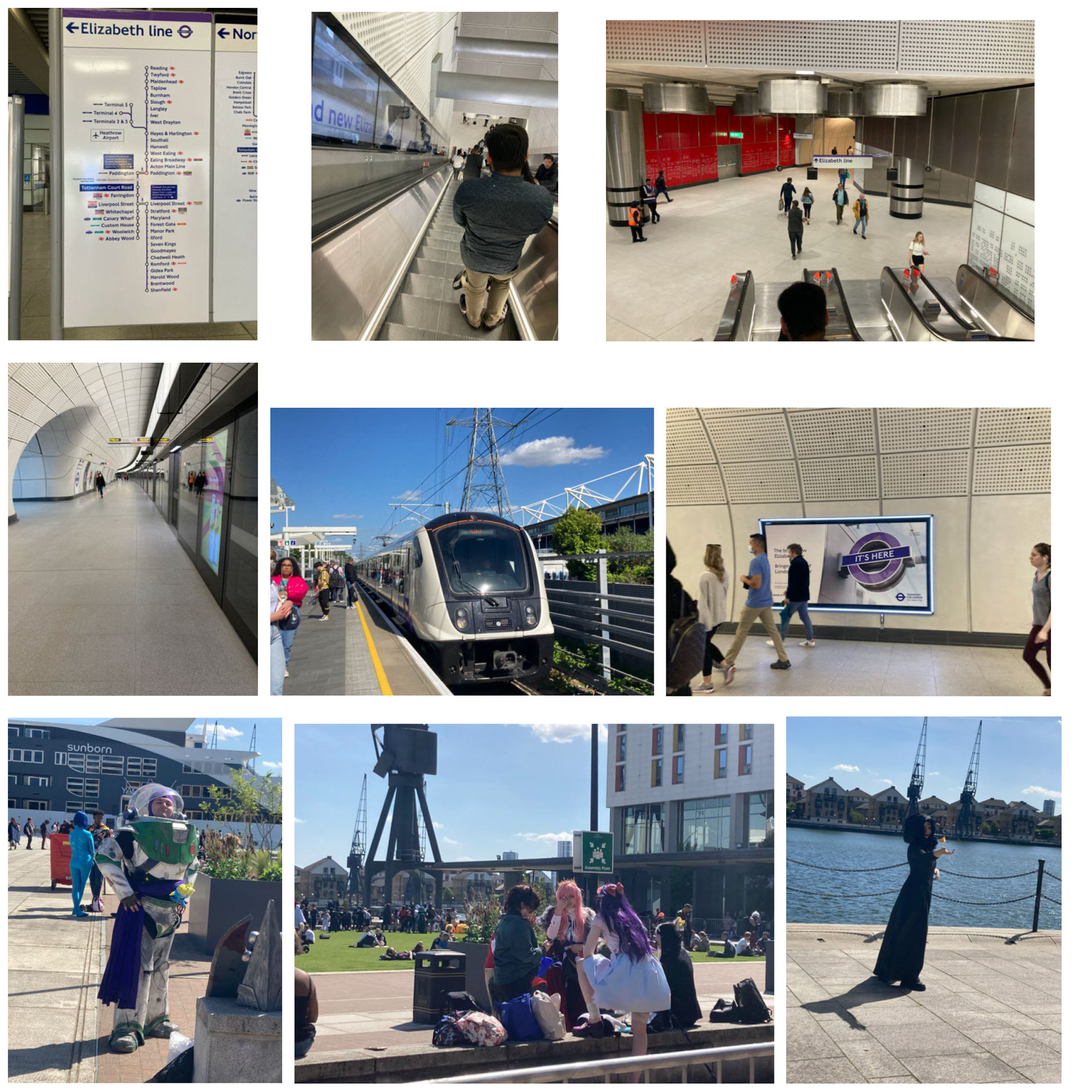
April Activity Report
30 April 2022
Global Japan Office Coordinator
Kazumi Taguchi
The April London Report is all about a meeting I had with a Tokyo University of Foreign Studies’ student, Ryôta Imamura, who has been studying at SOAS since last October. We made an arrangement to meet at a popular café in Russell Square.
I asked him about his experience at SOAS and here are some of his comments.
“My year studying abroad at SOAS has been an extremely rich experience for me.”
“The teaching method at SOAS is very flexible and respects students’ own initiative. I found this approach extremely rewarding and under these circumstances, I was able to expand the area of my interests in detail.”
“I took courses focusing on international relations and development studies. Personally, I wanted to study the immigrant situation. It was possible to choose classes which involved different departments. So, I studied immigrant and cultural anthropology as one unit and diaspora and development studies as another unit, and it was extremely useful for me.”
“In the UK, there are issues concerning immigration and racial discrimination, but at the same time, there is a lot of awareness and a lot of positive steps are being taken to tackle and understand these issues and solve the problems which have arisen. I find it sad that in Japan there is not much chance to discuss the question of racial discrimination.”
“In SOAS, white people are a minority and students come from all kinds of different racial backgrounds. In this sense, I think SOAS is a very special school within the universities in the UK.”
“I was impressed by the system in place because it really facilitates the understanding of different cultures from around the world. It made me aware there are many people who are interested in and enthusiastic about studying and learning about different cultures.”
“Students are sensitive and highly aware about the issues of racial discrimination, and I can see that they have a strong determination to change and create a better society. Compared to Japanese society, there is far more discussion and debate about this subject.”
“Studying at SOAS, made me aware of the necessity of developing a critical viewpoint. I realise it is very important to avoid creating a situation where the developed countries pressurise the underdeveloped countries with their policies.”
I have come to understand that an approach of working together rather than separating developed countries from underdeveloped countries is necessary. In other words, we need to avoid pressurising from above and come to an understanding of each other.
“Just after arriving in the UK, I tested positive for Covid and had to self-isolate in my room for 10 days. Many people helped me out by delivering food and necessities. As a result, I realised every day here was precious and important.”
“Six students share the kitchen-dining room in the student accommodation where I’m staying. There are two other Japanese, one Chinese, one Vietnamese, and one American student.”
We cook and eat dinner together whenever it’s possible. We spend a lot of time together, and we’re all going to see the new Harry Potter film after this meeting. I feel we are a family, and in a way as if I’m some kind of character in a sit-com.
After talking to Imamura-san, I had a strong impression that he has really got a lot out of his year abroad. As well as enjoying the student and social life in the UK, I can see he has also been studying hard and expanding his knowledge in order to create a better society. In my opinion he is a young man with a lot of promise and commitment and it was a pleasure to hear of his invaluable experiences in the UK.
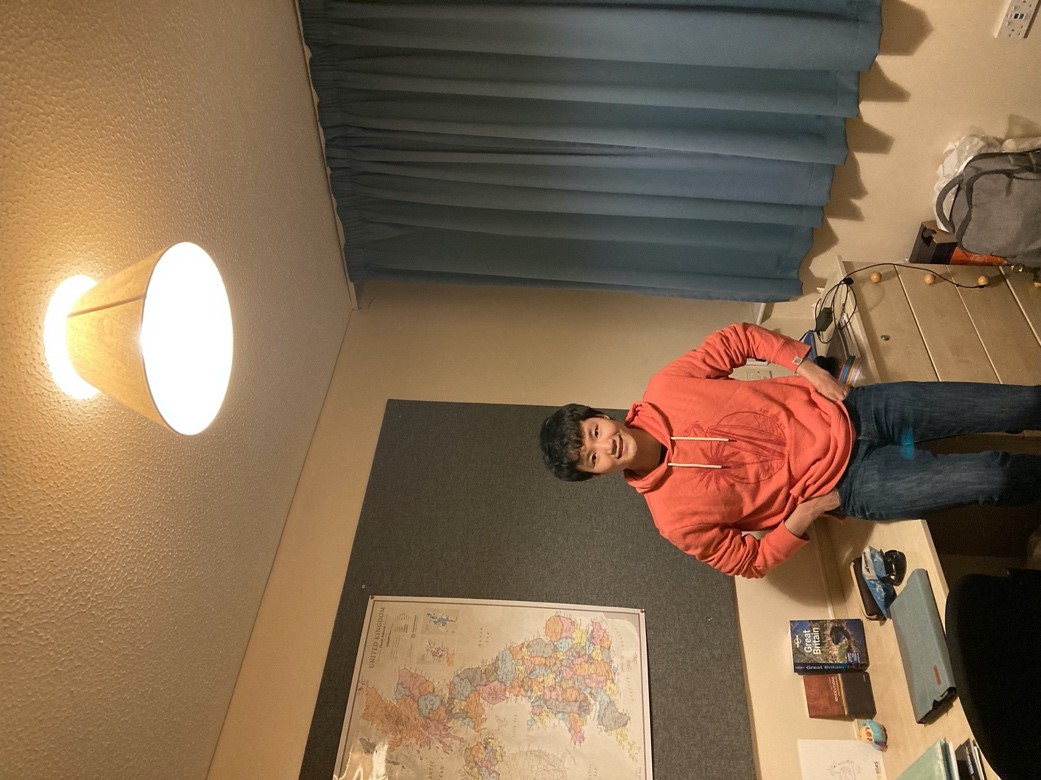
Ryôta in his room in student accommodation
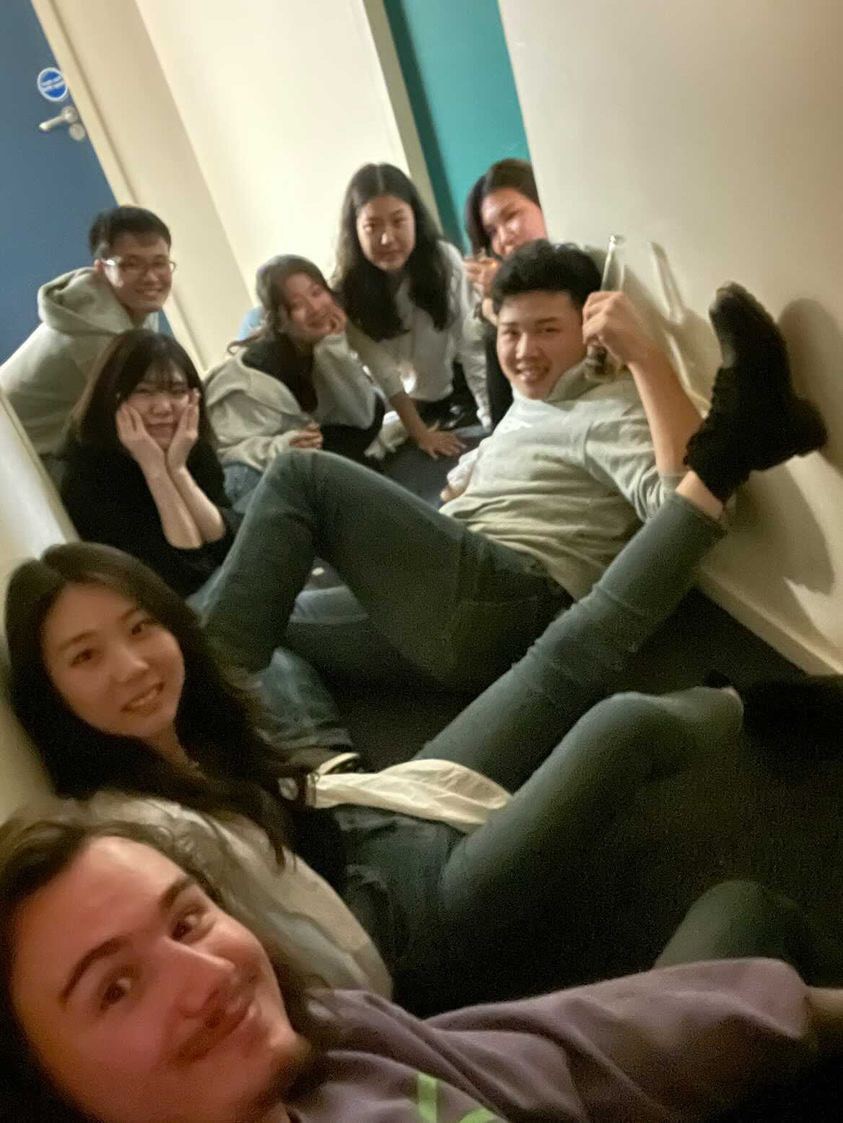
With his friends at the student accommodation
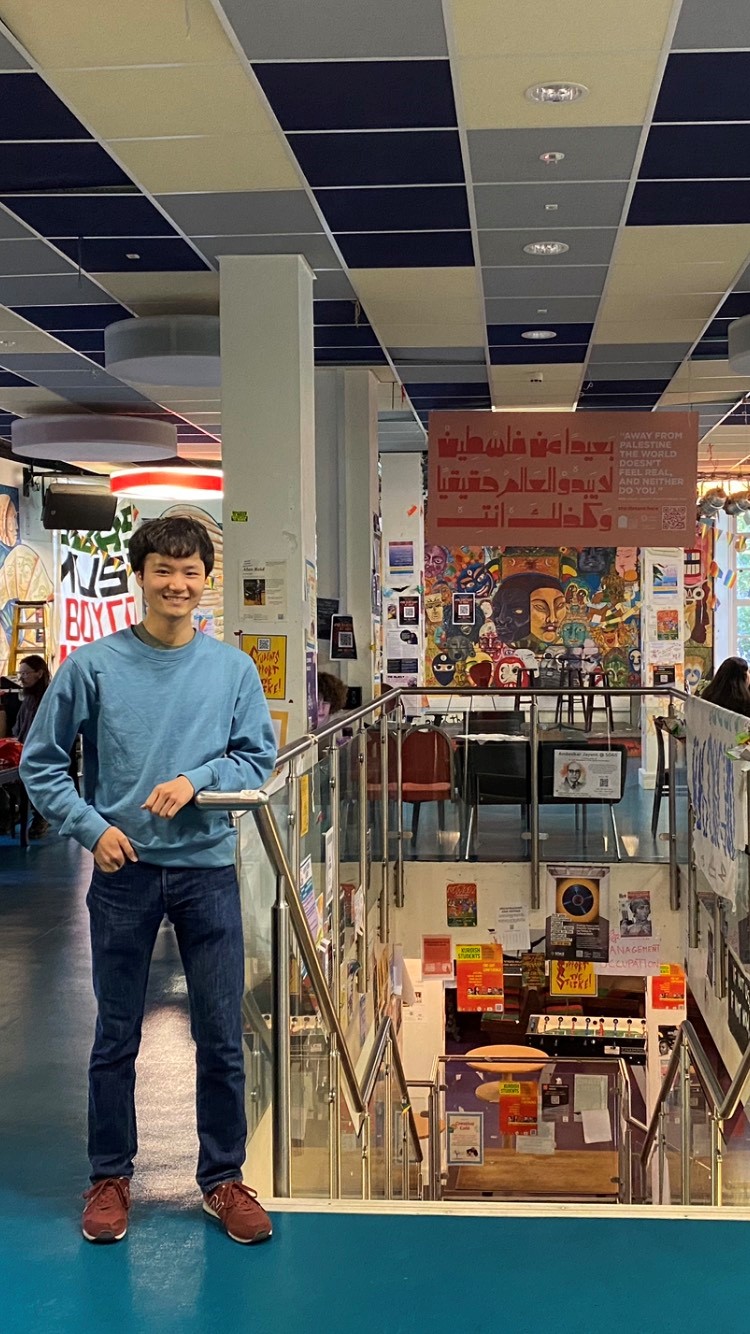
SOAS main building, Junior Common room and downstairs the SOAS bar
